#united by being at the bottom of the food chain
Explore tagged Tumblr posts
Text




prison boyfriends for sure
#united by being at the bottom of the food chain#justified fx#jeremy davies#dickie bennett#damon herriman#dewey crowe#screencaps
29 notes
·
View notes
Text
Visitor (a Trolls fanfic)
Summary: A month after his imprisonment, Veneer is paid a visit from someone he didn’t think he’d ever see again
__________________________________________
“Aw, no…”
Veneer moaned to himself, slumping down on his cot and facepalming in dismay. He was so not in the mood for this. He never was. And today it was hitting especially hard. Maybe because it had been exactly a month since his incarceration. Maybe because his attempt to speak to his sister had resulted in the throbbing pain that plagued his left cheek. Or maybe because of the haranguing speech that he knew awaited him once he left his cell.
He peeked a glance at the guard awaiting him, arms crossed and eyebrow raised as if to say “Well? Are you coming or not? You may have all day, but not everybody else does!” They were usually stoic, poker-faced, and unsympathetic towards inmates’ desires. Rightly so. Much of the prisoners were delinquents who, if shown even an ounce of freedom, would take it to the extreme. His own sister had learned the hard way when her request to have the ankle chain removed from her leg was surprisingly granted. The teen was quick to make a run for it, but even quicker to have been thwarted by the security. Veneer hadn't really seen Velvet around since, but from what he heard, she was taken into solitary confinement.
That was why he had made it his mission to be on his very best behavior. He'd speak when spoken to, eat the entire tray of slop that they called “food,” and hit the hay as soon as lights out was called. He never looked for fights or started any, and mostly kept to himself. So maybe, just maaaybe, if he asked really nicely, he could get out of this.
“Say, you know what? I'm not really sure if I can do this. You think maybe we could pick some other time?” Veneer grinned, hoping he looked and sounded polite.
But the guard was unmoved. "NO.”
“But… I'm really not feeling well!” It was a little true. Veneer's stomach was churning at the thought of leaving his cell for what was intended for him. In a desperate attempt, he clasped his hands together, stuck his bottom lip out in a pout and made his eyes big. “Pretty pleeeease?”
The guard had an unreadable expression for a moment, before he raised his walkie talkie up to his mouth to speak. “Increase the prison sentence for inmate number 8231978.”
Veneer dropped and act and gasped. “What? No! Okay, alright, I'll come!”
The guard humphed, unlocking the cell door so the teen could exit. With cuffs secured to his hands and an ankle chain to his left leg, the guard guided Veneer down the hallway.
The former Pop-star suppressed a groan and kept his eyes fixed to the ground. This was one of the parts he hated about this. The ‘Walk of Shame.’ The glares he'd receive. The jeers sent his way. Veneer wished he could burrow himself in the ground if it meant he didn't have to see the dirty looks being cast at him. And if looks could kill… Veneer shuddered to think that he'd probably be dead many times over.
Among other treacherous felonies, it seemed Mount Rageons truly despised frauds. Veneer supposed he understood why. It broke a golden value that was very challenging to win back - trust. He needn't look any further for an example of that, not only with what he and his sister had done, but also for his own sentiments towards her now. The resentment over Velvet’s manipulation… and the painful sorrow he felt in his heart at her stubbornness in refusing to ever speak to him again.
He focused on the sound of the clinking chain rather than the colorful words of the other inmates, and felt only a fraction of relief once he was out of that hallway and brought into the next room over. Veneer stared at the familiar tile flooring beneath his feet. It was perhaps slightly more welcoming in sight than the cell units, for its brighter lights and fresher smell. But that's where the welcome wore out. So far, this room hadn't been a place of positivity for him.
Veneer lifted his head slightly to assess the scene today. The booths were not as busy as it could be, which he was silently grateful for. The less folks to see him, the better. Inmates, all donning the same shabby orange jumpsuit he had on, were seated at them and already engaged in their own conversations with the recipients on the other end of the glass that separated them. He heard snippets of the chatting as he passed by.
“Six more months in the brig, can you believe it? Six months! I'll be old and wrinkled by then - “
“ - and you can't even tell the difference between the chicken and the broccoli sometimes. Ugh, it's awful! How can that even be allowed? That should be a crime!”
“Friends? In prison? Pfft, come on, dude! This isn't gradeschool - “
Veneer attempted to swallow down the lump in his throat, and thought about who his visitor would be this time around. Maybe it was a Mount Rageon, reminding him of how they used to be a fan of his music until he turned out to be a phony, while he sat, quietly mumbling an “I'm sorry” that fell deaf upon their ears. Or, they could whisper about how they still liked him, and believed that the whole Troll-talent thing was an elaborate hoax to spice up the drama. Veneer hated that scenario more than the first, and he would get frustrated in explaining that his jail-time was deserved. Or maybe still, it could be his parents, there to chew him out and express their disappointment in him and his sister. The first time they'd come, Veneer had easily taken the verbal beating, but Velvet only had her anger spiked. He shuddered remembering the way she'd spewed a string of obscenities so foul, even a sailor would be put to shame.
Veneer didn’t dare look up to see who it was at the booth when the guard told him to be seated. He just picked up the phone, and tried to sound somewhat alive as he mumbled into it.
“Hello?”
“It isn't as hip as your old pad, but at least it's something, huh?”
Veneer gasped, recognizing the serene voice at once, and whipped his head up. “Floyd?”
Sure enough, it was the teal Troll speaking into the phone’s receiver. When Floyd offered a gentle smile, Veneer couldn’t help grinning back. Floyd had that effect on folks, it seemed, one of shining positivity even in the darkest times. But that grin disappeared when he caught sight of the Troll’s hair, a rich sweep of magenta… save for the significant white streaks that ran through it. Ones that had been caused by Veneer’s own doing. The guilt bit at him, and the teen suddenly didn’t feel comfort in his unexpected presence. “Floyd, what are you doing here?”
“What do you mean? I came to see you,” he answered simply.
“Why?” Veneer asked, flailing his arms in a baffled manner. “If I were you, I’d be the last person I’d wanna see!” It was only when the guard standing at the far end of the room had shot him a warning look that Veneer realized his outburst had been too loud, and he toned it down.
“That’s not true, Veneer,” Floyd said, and then he smirked. “I’d say your sister wins in that category, wouldn’t you?”
Veneer had to chuckle at that. “Yeah, you are so not wrong there.”
Floyd laughed a little, too, and then spoke again. “But even then, I’m still gonna try to talk to her at some point, too.”
“Good luck with that,” the former Pop-star scoffed. “Anytime I’ve tried to talk to her, it just ends like this.” He turned his face to the side a little so Floyd could see the ugly purplish bruise that was his left cheek.
The Troll winced. “Ouch.”
“Ouch is right,” Veneer whimpered, gently touching the injury in hopes that perhaps it didn’t throb as much. Nope. Still did. He pinched the bridge of his nose and gave an exasperated groan, unable to contain it in him anymore. “So much for my sister not treating me like garbage. This has literally been the worst month of my life! Vel’s never gonna talk to me again. This uniform stinks! And you can only chop so many rocks before it starts to get to your head…” He huffed and heaved a sigh. “You’re SO lucky you don’t ever have to go through something like this. You’ve probably never done one bad thing in your life!”
Veneer expected him to agree right away, but became curious at Floyd’s silence, and the shamed look accompanying it. “Don’t be so sure.”
The teen cocked his head. “Wha?”
The Troll nodded. “I did something twenty years ago that I regret to this very day.”
“Geez,” Veneer said, considering the amount of time. He was hardly twenty years of age himself! “What happened?”
“I abandoned my baby brother. I promised I’d come back, but I never did…” Floyd’s voice got quieter as he continued to explain. “Turned out he wasn’t as well off as I thought he’d be. Our Grandma died, and there wasn’t anybody else to take care of him.”
Veneer winced. “Oof. Sounds rough.”
“Believe me, he let me know,” Floyd confirmed. “He was pretty upset. But then do you know what happened?”
“What?”
“He forgave me. Sure, it’s gonna take some time to heal the hurt of the past, but we know we can do it. And I'm confident that you and Velvet can do it, too.”
But Veneer disagreed. “How can you say that?” he blurted. “You’ve seen Vel. You’ll have better luck talking to a brick wall! It’s hopeless!”
Floyd paused for a moment, considering his next words. “You know, I felt pretty hopeless inside that diamond. You seemed pretty in love with all that fame and money, and whatever other ‘bling-a-ding’ you had…”
“Don’t remind me,” the teen whimpered, embarrassed for the selfish behavior he’d exhibited.
“And yet, you listened to me… didn’t you?”
“Yeah…” he replied warily.
“Then I trust Velvet can with you.”
“But you don’t understand!” Veneer cried. “Vel and I aren’t the same! Well… not entirely,” he amended, recalling how he and she hadn't been so different when it came to their desires for fame and fortune. “Just because I listened doesn’t mean Velvet will. That part of her that would listen has been long gone.”
Floyd cocked his head. “What part?” he pressed.
“Oh, you know,” Veneer went on, “the part that liked to make up bad dances, and didn’t care if we sang off key, as long as we were having fun.”
“Ohh,” The Troll said, nodding in understanding. “But you never know. That part of her could still exist.”
Veneer gave a dry laugh. “Yeah right.”
“I’m serious,” Floyd said. “She’s still there. You just gotta help her find it again.”
The teen eyed the Troll. “You really, truly think that’s possible?”
“Cross my heart, hope to die.”
“Let’s hope not,” Veneer said, feeling a shudder go down his spine as he remembered the way the Troll had gone transparent and nearly succumbed to death. But then he thought about what the magenta Troll said. Velvet being that sister she once was? It would be wonderful. “I guess she's been a diva for so long, I never thought it'd be possible for her to change…”
“It is,” Floyd assured with a smile. “It really is.”
Suddenly, a ping resounded, and he looked down at the bracelet on his wrist and gasped. “Oh! I promised my brothers I’d be only fifteen minutes. Otherwise, they wouldn’t have even let me come. They’re outside waiting for me. I’m sorry.”
Veneer nodded. “It’s all right, I understand. You don’t have to apologize.”
“Thanks. It was nice talking to you,” Floyd said sincerely. “Ooo, and make sure you check the mail! The letter I sent should have arrived today.”
Veneer nodded again. “Oh! Okay, I will. And it was nice talking to you, too!”
Floyd smiled, and was about to head off, when Veneer stopped him. “Wait! I, um… do you have a quick second? I've been working on something… I was kinda hoping you might wanna hear it?”
As Floyd glanced at him expectantly, Veneer cleared his throat, suddenly second-guessing himself. What if he sounded awful? What if Floyd laughed at him? Regardless, he’d already stopped him, so he had to follow through. The song flowed out of him softly at first, his voice cracking a couple of times and making him inwardly cringe. But soon his voice became stronger, the notes rich and beautiful. When Veneer was done, he was met not only by applause from Floyd, but from the other inmates and recipients at the booths as well! He blushed as Floyd offered his compliments.
“That was great!”
“And I swear it was all me,” Veneer hurriedly explained. “No talent-stealing here!”
Floyd chuckled. “That’s good. You really do have some real talent.”
Veneer shrugged. “Guess I just had to work hard at it.”
Floyd gave him a thumbs up. “Right.” Then he turned to go. “I’ll see you around, Veneer.”
The Troll waved, and he waved back. A sense of uplifting filled Veneer. He was in slightly better spirits than he had anticipated himself to feel, and was glad for it. On his way back to the cell, he questioned the guard on any mail delivery for him, and true to Floyd’s word, one letter, sealed with the BroZone lightning emblem, was awaiting him.
Veneer didn’t waste a minute as he tore open the envelope and began to read:
Veneer,
It’s amazing how time passes by so quickly. I can hardly believe it’s already been a month’s time since the incident, of which I don’t believe you need me to mention for you to know what I’m talking about. But, I AM going to mention it anyhow, as it was an experience which has produced great effect. I also see this as an opportunity to debunk or confirm any assumptions you may have regarding me on the matter.
Spending two months encased within a small, and rather uncomfortable diamond imprisonment was, to put it bluntly, an awful experience for me to have undergone, as I’m sure you can imagine. I can’t lie there, or try to sugarcoat anything. Matters were not helped when you were under the impression that this was a necessary thing to do. But shortcuts can sometimes be more ‘cut’ than ‘short,’ as came to be you and your sister’s case. But this is not to say that cuts can’t heal. With time and learning they can, and from there, things are bound to get better.
In the same manner that everyone deserves to be treated kindly, everyone also deserves a second chance. I can’t say that the first impression you left of me was a good one, but have an inkling that my sentiments will change in the near future. Know that you are forgiven for your actions, so long as you understand where your mistakes were, and so long as you have learned from it. I know I can’t make you heed to any advice that I or anybody else may give you, though I strongly recommend taking it, for your own benefit.
I have been on my way to recovery from everything, and am living with my brothers. If you are interested, I can speak to the prison management team and see if we could get you work release at my older brother’s cantina. It’s on a beautiful little island that I think you will find quite becoming (plus, it has a karaoke stage!)
By this point, I would imagine that we would have already spoken to each other, and, should the conversation have gone the way I envisioned, I believe that we can likely look forward to speaking again.
Your friend,
Floyd
P.S. If you choose to respond to this letter, send it out attached with the postcard in the envelope. Trust me, it will get there :)
Veneer wondered what he meant by that last part, and soon understood when he pulled out the said postcard - with no return address or sender information. But, he shrugged it off. If Floyd had said it would get there, then surely it would get there! And so, Veneer got to work composing a return letter, finishing it with just a few seconds to spare before lights out. The letter looked something like this:
Floyd,
It was unexpected seeing you today. If I was in your place, I would have just moved on with my life and not looked back - especially at the guys who captured me. I want you to know that I am very, VERY sorry for what I did to you and regret it very much. You can take my word that I will never do something like that again to anybody. I was too afraid to say anything about it to my sister before, but now she knows where I stand on this. I hope you’re right and that she will come around one day…
I’m glad to hear that you are recovering and hope that you continue to regain your health. I think that work release idea sounds great! (Although, I’ve never been to an island before… do you mind telling me a little bit about what it’s like?)
I was afraid to talk to you at first, but I actually did like the turnout of it and, if you have any time to spare in the future, I really would like for us to talk again!
Sincerely,
Veneer
P.S. Gonna try and have the full version of that song ready by the time you come back :)
__________________________________________ A/N: I like the idea of Floyd and Veneer becoming friends after the whole ordeal
#trolls#trolls 3#trolls band together#floyd trolls#veneer trolls#velvet trolls#velvet and veneer#branch trolls#dreamworks#fanfiction#kittyball writes#brodacious fanfiction#100+
231 notes
·
View notes
Text
I am back home from vacation in Isla Mujeres. Sheila is staying a few more days. We know other visitors on the island. Sheila is hanging out with them this week.
The Island is a 25 minute ferry ride from Cancun. It is about tourism, but not at all like being inside an all-inclusive resort. Many folks we ran into visit Isla for several weeks at a time and stay in small condos or rooms.
(A bit long, with pictures, below the cut)
We rented a two-bedroom place in a small, four-unit building. It was at the north end of the island. That's where many of the American and Canadian visitors stay. But locals live there too. From our roof we could see the family next door, cooking and putting out their laundry to dry. Our door is the blue one in the bottom left picture.
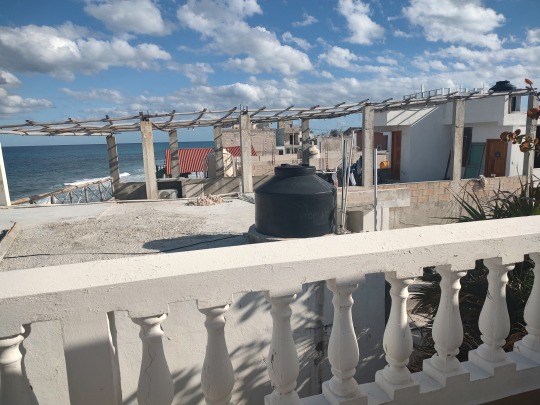



Some US hotels I've been at lately don't offer daily changes of sheets and towels. "For the sake of the environment," ya know. Our modest place in Isla included fresh sheets and towels every day in addition to full room cleaning. It felt luxurious.
More local people live mid-island and to the south end. However, visitors rent places all over the narrow island. A couple we know has the equivalent of a studio apartment mid-island for two months at $600/month. A realtor would call it "Very cozy." I liked it.
That couple has bicycles they store there for when they come back each winter. They also rent a golf cart from time to time to drive around the island, as many visitors do. Some Americans and Canadians purchase places instead of renting. Some beautiful, modern houses dot the island.
One of the first things I did upon arrival was slather myself in SPF 50 sunscreen. My pasty white head and back made the soft, white beach sand look like black pepper in comparison. The sunscreen worked well. I have only one small patch of burned skin where I missed covering a spot on one ankle.
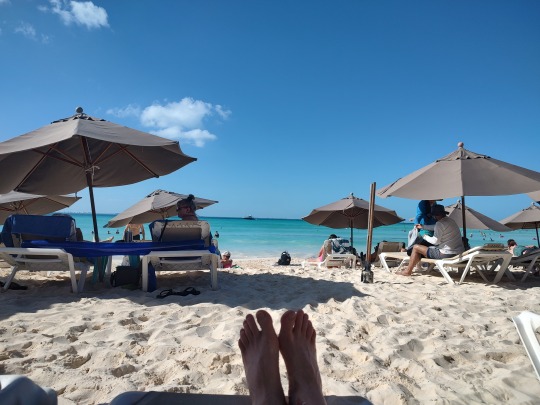
You won't find chain restaurants here. The few banks and gas stations have familiar names, but that's about it for big brands.
Warning signs are few and far between. Servers bring cold beer to the beach, in glass bottles. This was my fourth or fifth visit and Sheila's 12th. We've never seen or heard someone break a bottle. There are no lifeguards at beaches or pools.
When crossing roads, cars, golf carts, and scooters seem to have the right-of-way over pedestrians. Sidewalks are rough and uneven. You learn to be careful and pay attention. At times soldiers and police patrolled the streets with rifles. We felt secure the whole time, even while walking in dimly lit local neighborhoods.
One resort-like place where we hung out at for a few hours has a pool with concrete seats and tables in the water. A server, seeing me cooling off in the water, asked if I'd deliver a glass ashtray to four women sitting at table in the pool.
Smoking isn't allowed inside bars and restaurants, thank God. Unlike the US where that's just understood, there are some No Fumar signs posted in Isla businesses. I bet I didn't see more than a dozen people smoking the whole time I was there.
Touristy stuff is there if you want that. Two streets have vendors hawking t-shirts, magnets, and such. Scuba and fishing trips are available if that's your thing. Golf carts and scooters can be rented. Mainly I eat good food, drink relatively inexpensive drinks and cheap beer, read, and relax. Surprisingly though, I recorded 10,000 or more steps every day.

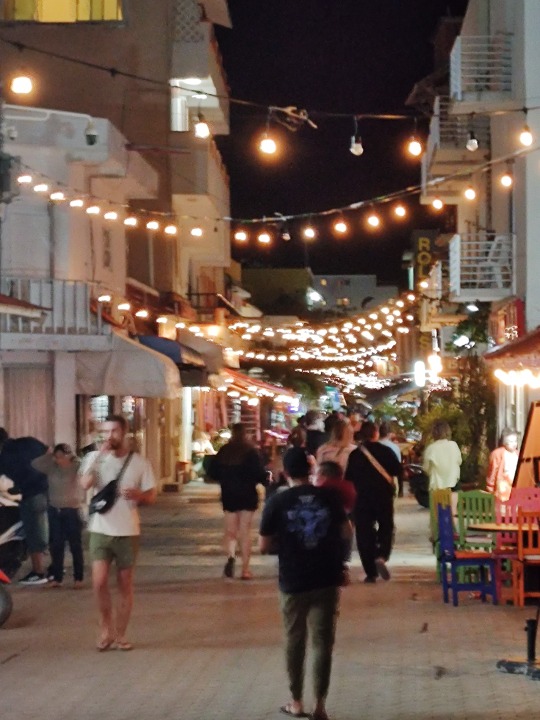
Many of the older buildings would make an American code inspector twitch with anxiety. Few stairs, even very steep ones, have railings. Nor do all the rooftops. Our place had a railing on top but the buildings next to us did not. A realtor might call those "Unencumbered terraces." I easily could have done one of those cop TV show stunts, jumping from building to building while chasing a perp down the block.
Try tracing these wires. Or finding the source of the water lines. A realtor might say "Plentiful utilities." We did have excellent water pressure, hot and cold. Just don't drink it.
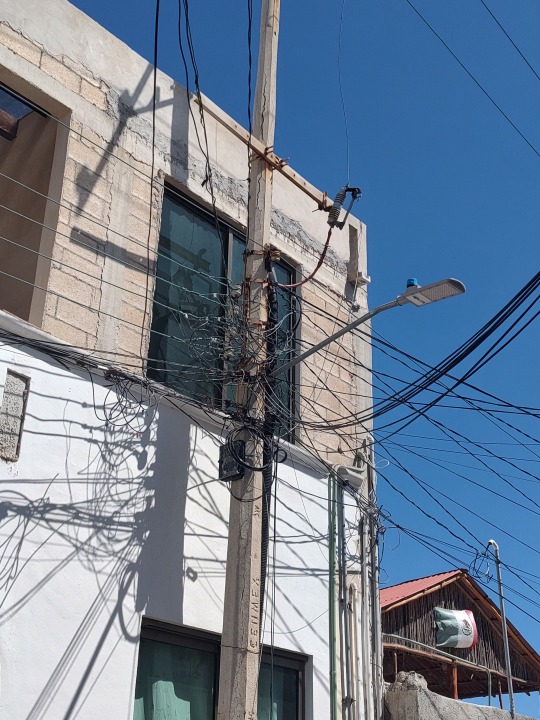
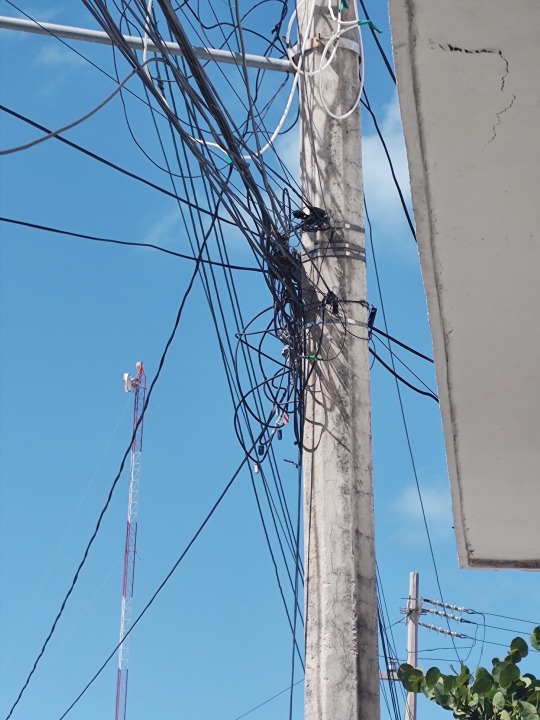
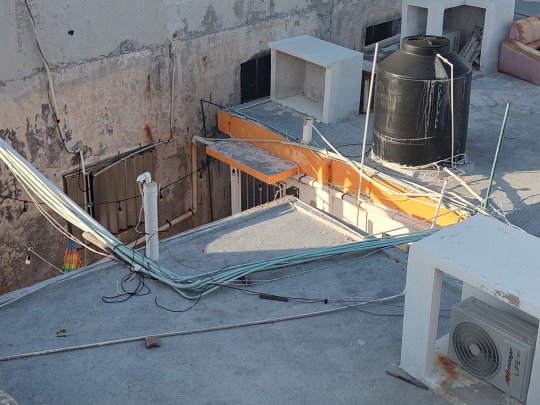
Bathrooms in some bars and restaurants... oh my. An Applebee's is more sanitary, but then you are eating at Applebee's. About ten years ago one of Sheila's friends purchased a toilet seat with her own money and installed it herself in one of the island's bars she liked to frequent. She had developed some nice leg muscles from so much hovering. Life's trade-offs, right?
One bar's women's room has a lot of comments in Sharpie about Mark. Some female out there somewhere DOES NOT LIKE MARK. Apparently a frequent visitor to the island, she documents when bad thoughts of Mark cross her mind. The men's room offered some scribbles both for and against Mark. At our table a group of us sat around trying to come up with the story. It could have a chance at being a Netflix/Hulu movie.
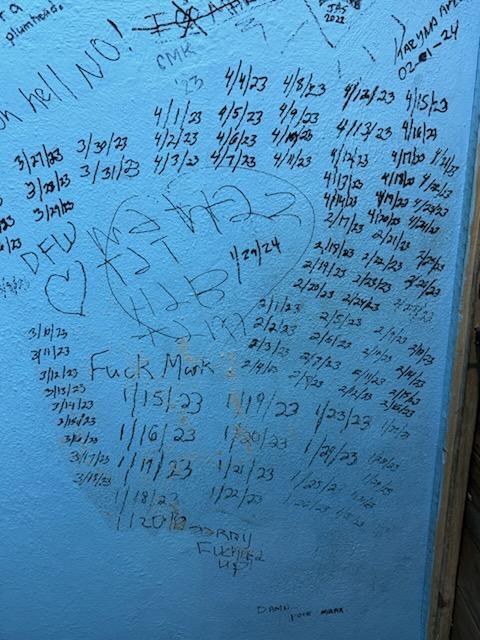
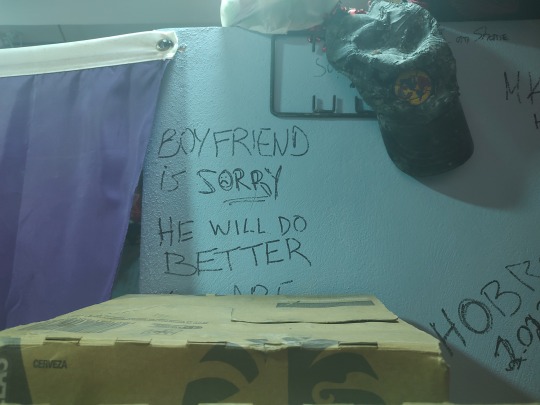
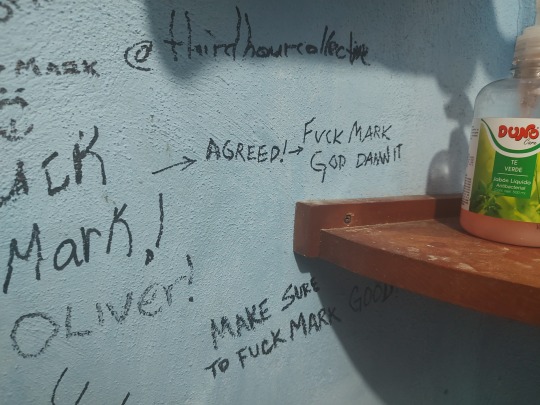

We didn't cook. There are too many local places that are fun and tasty. In some parts of the island you can actually order a meal at someone's house and eat on their patio. I'll have a separate post later about how we hired local guy bring us to seven different places for food one night.
Several times we shared restaurant tables with other visitors, some we knew from previous visits, some total strangers. A couple from New Jersey wanted to sit on the patio at a restaurant Sheila and I like. All three outside tables were occupied. We had empty chairs at ours, so we invited them to join us and had a wonderful evening talking with them. The wife did sound a bit like Carmela Soprano. Her husband, however, did not make me remove my cap. Another restaurant had a cat you could pet during dinner at another place.
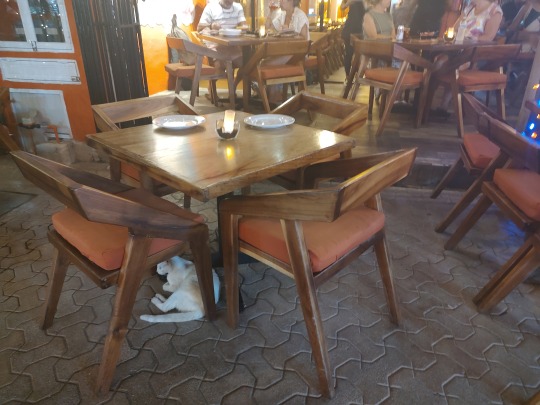
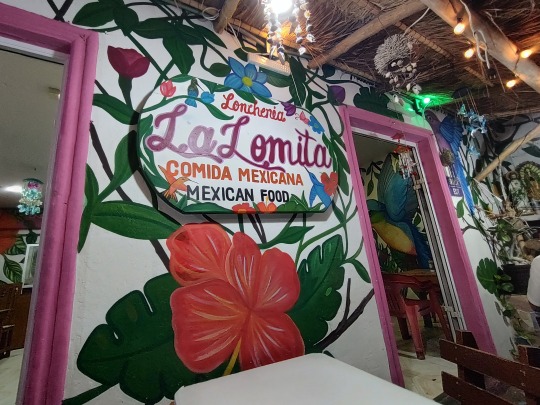
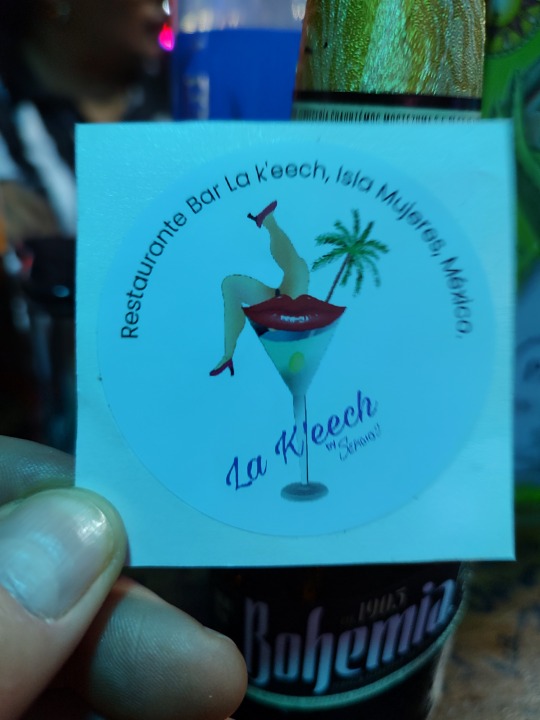
In addition to the restaurant cat there were sidewalk dogs. They putter around or relax on the warm pavement. People walk and drive around the dogs. I assure you that white dog in the right picture is just sleeping contentedly. I didn't use a flash, so I wouldn't disturb him. The little one on the left greeted me as I walked along the malecón on my way to a massage.
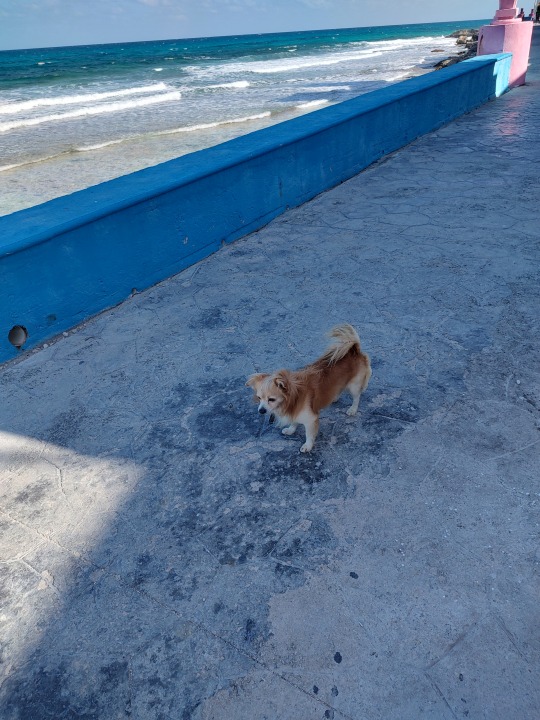

We played pickle ball while there. The courts were in the middle of an area with few tourists. All the players were Americans. I wonder what the local residents think of the game with the bright, plastic balls that go clink, clink, clink. That's me in the yellow hat (top left picture). The bottom two pictures are what was behind the courts.
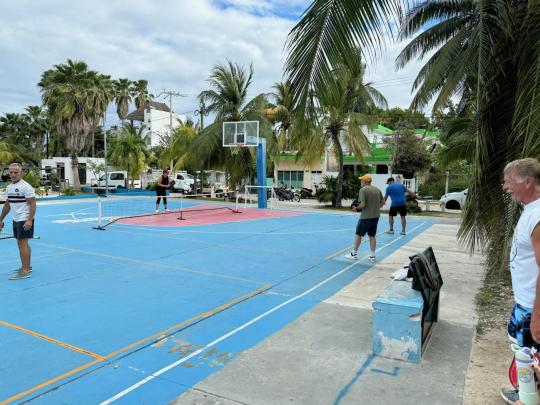



I could get used to scooter life. Sheila has one at home, but it's engine is literally six times the size of what these ones here have.
Carnival celebrations began on Friday. Our place overlooked the town square, by the Catholic Church. It was fun to watch the celebration with the loud music and lots of people.

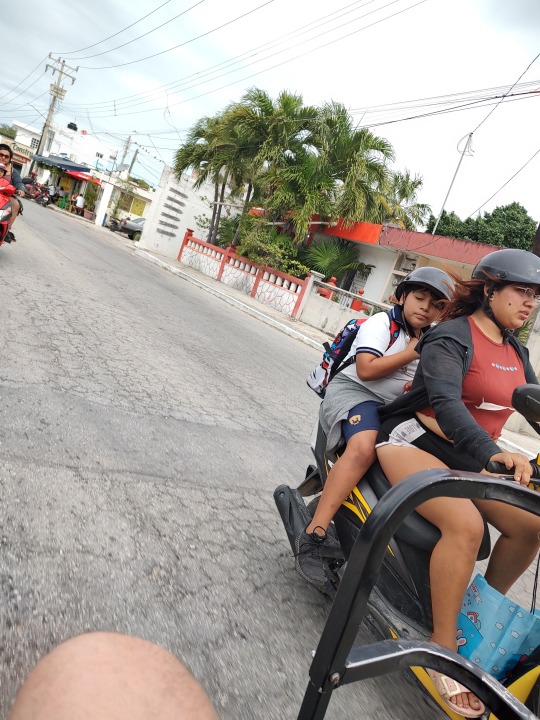

That got long! Enough for now.
52 notes
·
View notes
Text
i think the reason re8 wasn't as well executed as re7 is because they tried to convey too many things at once.
in re7 the main villain is a 10 year old girl abused by a secret corporation that wants to turn her into a bioweapon when all she wants is a normal family. however she has only ever known authority and hierarchy, not the love and affection that should exist within an actual family, therefore she is only able to create a toxic home with a strict hierarchy where every new member is at the bottom of the food chain. jack is the abusive father who delights in torturing his children, marguerite is reduced to her reproductive organs, as her role is solely that of the mother who bears new children, and is otherwise just a very disguting annoyance. lucas is the product of this toxic home, showing that it isn't genetics that play the biggest role in the child's education (he has been cured of the mold and is acting solely of his own free will) and that cycles of violence and abuse are not easily broken. however they can be broken, and we see that in zoe, who goes out of her way and risks her own life to help ethan. mia, while technically the "younger sibling", is probably just a step above lucas in the hierarchy because of her bond with eveline and her ability to adapt. when ethan "joins" the little family unit, he is nothing but the scared little kid who's just trying to run and hide from his father, a practically impossible task in the claustrophobic house.
this all works because this is all the game is about. it's not trying to be anything else or to make bigger statements or commentary. the first re game was about the collapse and moral corruption of modern society (with the cannibal zombies) as well as the obsession with modernizing warfare by developing bioweapons to be used arbitrarily on the civilian population, who become mere test subjects for the military industrial complex.
re7 focuses on the moral decay of the family unit as a sort of case study for the larger aforementioned collapse of modern society, as it is both a direct result of a human-made biochemical disaster and the sum of every toxic and abusive ideal of patriarchal society.
re8 at its core is about pollution, with moreau being the most self explainatory case. however, the problem with re8 is that every one of the four lords represents a different thing, and the player doesnt really get enough time with any of them to really unpack anything. re8 tries to recreate the family unit we had in re7 but at the same time it wants to talk about how the nobility is nothing but a very pretty looking blood sucking parasite, and also about how pollution is bad for the fish, and about how technological advancement requires the utter annihilation of the natural landscape to make way for factories that produce machine-human hybrids, but it's also about family.
mother miranda tries to make a family for herself, but she fails miserably as she isn't interested in any of her "children", instead focused on exploiting them to create the perfect child. alcina, the nobility, has some pretty evident issues with authority; she's used to being the ruling class, the one with all the power and who exploits those below her; she also has daughters of her own, so she clearly isn't interested in miranda's plans. moreau is the most pathetic and also most obvious Lord Of Pollution, as there is nothing else really going on with him. he is a poisonous creature the spreads disease at his every breath. heisenberg is the rebellious son who wants to break away from his overbearing mother's control, the mother who put him on earth without his permission, who changed him without his permission, but he is the worst kind of pollution that exists: war. he cannot break the cycle and is not interested in doing so.
donna is the one that stands out the most to me, as she doesnt really represent any kind of physical pollution, but rather something that is plaguing our modern society on a much larger scale than ever before: metal illness. she is also the one who, more than any other lord, personifies the theme of the sick and twisted family; she taunts ethan with his insecurities about being a parent, about his own body and his own "wrongs" that his child might have inherited from him (scary giant fetus). she also makes him to take apart a mannequin modeled after mia, his dead wife, forcing him to deal with his grief and and fear to lose the only family he has left: rose.
it's not a bad game at all, and every lord is a very compelling villain (except maybe moreau) but the game doesnt give any of them nearly enough time to be developed fully and to be truly, undeniably monstrous. not to mention mother miranda, who barely feels like a villain by the end of the game, she's just annoying.
tl;dr: it's a good game, i realy liked it, but it could have benefited from having less characters and from focusing more on the horror than on the action doom-like style of gameplay
#just random thoughts sorry. also im relatively new the RE universe so bear with me#resident evil#resident evil village#re8#re7#resident evil biohazard#oh btw i know the other games after re1&2 are more action than horror but re8 is very much advertised as a survival horror game#just like re7 but i think re7 does a much better job than re8#gaming
33 notes
·
View notes
Text
BOYFRIEND MATERIAL
chapter OO8: WHO IS IT?

[ CHAPTER INDEX ] [ PREV CHAPTER ] [ NEXT CHAPTER ]





You did as told, catching a taxi to drive you towards your destination. "Can you take me to Subway? Near the Golden Mansion. Thank you," you stated, the taxi driver nodded before he played some songs to play in the stereo, you humming to it as you went towards Subway.
Several minutes later and you've finally arrived, going out of the taxi after paying the exact fee. "Shit. My money's not enough. Well, Jay's driving home anyway," you stated before you stood outside the fast-food chain. A little while later, you were growing tired and decided to play something on your phone.
But as soon as you felt your pockets for your phone, you realized you've left it back at your unit. "Oh fuck me," you cussed as you stomped your right foot in anger. With a sigh, you dropped down to the floor and continued to wait...and wait....and wait, but Jay still hasn't showed up.
What the fuck? Where the hell is that mongrel? You thought to yourself, then finally realized that Jay's kindness was just to make a fool out of you. And with not enough money pay for a taxi, you knew you were doomed and done for. "I'm gonna fucking kill him when I see him. It only gets worse. I forgot my phone."
Having no means of going back to your condo, you began to panic as you bit your bottom lip in concentration, trying to think of any possible way to get back. Should I just ask help from the customers here? You thought but shoved it away, not wanting to communicate with strangers.
And as if an angel has heard your pleas, a voice you were quite familiar yet unfamiliar with sounded through your ears. "M/N? What are you doing here?" Heeseung asked you with a raised brow, making you look at him. He was holding onto a guitar case and a microphone case.
"Jay asked me out on a simple dinner but he never showed up. He's just being a douchebag," you explained, Heeseung's eyes turning into what seemd like rage before it softens as he looked back at his bike.
He grinned. "I'll take you back to your condo unit. But, I bet your hungry. C'mon, my treat."
Heeseung's genuine kindness made your heart flutter, unlike some jerk out there. But you entered Subway along with Heeseung who walked towards the counter. "Two orders of my usual please," Heeseung stated before handing his card.
"Thanks, Heeseung."




53 notes
·
View notes
Text
After decades of strategic drift and costly acquisition failures, the U.S. Navy is sailing straight into a storm it can’t avoid. Despite the Defense Department’s lip service about China being the “pacing challenge,” decades of deindustrialization and policymakers’ failure to prioritize among services and threats have left the Navy ill-equipped to endure a sustained high-intensity conflict in the Pacific. The United States is unable to keep pace with Chinese shipbuilding and will fall even further behind in the coming years. Where does that leave the U.S. Navy and the most critical U.S. foreign-policy imperative: deterring a war in the Pacific?
As evidenced by the Biden administration’s latest budget request, fiscal constraints are forcing the Navy to cut procurement requests, delay modernization programs, and retire ships early. The Navy’s budget for the 2025 fiscal year calls for decommissioning 19 ships—including three nuclear-powered attack submarines and four guided-missile cruisers—while procuring only six new vessels. The full scope of what military analysts have long warned would be the “Terrible ’20s” is now evident: The expensive upgrading of the U.S. nuclear triad, simultaneous modernization efforts across the services, and the constraint of rising government debt are compelling the Pentagon to make tough choices about what it can and cannot pay for.
Workforce shortages and supply chain issues are also limiting shipbuilding capacity. The defense industrial base is still struggling to recover from post-Cold War budget cuts that dramatically shrank U.S. defense manufacturing. The Navy needs more shipyard capacity, but finding enough qualified workers for the yards remains the biggest barrier to expanding production. The shipbuilding industry is struggling to attract talent, losing out to fast food restaurants that offer better pay and benefits for entry-level employees. At bottom, it is a lack of welders, not widgets, that must be overcome if the U.S. Navy is to grow its fleet.
Instead, the shipbuilding outlook is progressively worsening. An internal review ordered by Navy Secretary Carlos Del Toro in January found that major programs, including submarines and aircraft carriers, face lengthy delays. Even the Constellation-class frigates, touted as a quick adaptation of a proven European design, are delayed by three years.
As defense analyst David Alman outlined in a prize-winning essay for the U.S. Naval Institute’s Proceedings, the United States simply can’t win a warship race with China. The United States effectively gave up on commercial shipbuilding during the Reagan administration in the name of free trade. In the decades that followed, generous state subsidies helped China dominate commercial shipbuilding, and Beijing’s requirement that the sector be dual-use resulted in an industry that can shift to production and ship repair for the military during a conflict, much as U.S. shipyards did during World War II. The U.S. Office of Naval Intelligence estimates that China now has 232 times the shipbuilding capacity of the United States. China built almost half the world’s new ships in 2022, whereas U.S. shipyards produced just 0.13 percent.
Rebuilding the arsenal of democracy that anchored the U.S. victory at sea 80 years ago won’t happen overnight or cheaply—it is a generational project. The 20-year Shipyard Infrastructure Optimization Program aimed at upgrading dry docks, facilities, and equipment will end up costing well over the projected $21 billion. But the plan is only intended to maximize existing U.S. industrial capacity and won’t do much to close the enormous shipbuilding gap with China. That would require a reconstitution program on par with the series of maritime laws passed after World War I, which supported the expansion of an industrial base eventually capable of turning out thousands of carriers, destroyers, submarines, frigates, and cargo ships for the Atlantic and Pacific fleets.
Realizing that U.S. shipyards are stretched thin, policymakers have begun looking abroad. Del Toro encouraged South Korean companies to invest in U.S. naval shipping during a visit this year. Japan will likely begin performing repair and maintenance work on U.S. warships soon; India agreed to do so last year. These initiatives will alleviate the increasing maintenance backlog at U.S. facilities, but it would take a large share of the combined Japanese and South Korean shipyard capacity to fundamentally alter the growing disparity between the U.S. and Chinese fleet size in the Western Pacific.
Ships are not all comparable, of course. U.S. warships are heavier and more capable than China’s, although a dearth of logistics vessels and sealift capability are major concerns. Still, the current era of missile warfare has magnified the importance of fleet size.
Without enough ships to match the Chinese People’s Liberation Army Navy, what can the United States do to maintain conventional deterrence in the Pacific and prevent war? At least two big things: buy missiles and cut back on missions.
First, to manage risk in the short term, the Navy and the other services need to rapidly procure more munitions—focusing on weapons and capabilities, not the platforms that carry them.
The Russia-Ukraine war has military planners thinking less about short, quick conflicts and more about long wars and their vast need for materiel. What holds for depleted stocks of land-based artillery also holds for many of the weapons needed for a war at sea. A much-publicized 2023 wargame conducted by the Center for Strategic and International Studies found that the United States would run out of its entire inventory of the key Long Range Anti-Ship Missile within the first few days of a war over Taiwan. Ramping up the procurement and production of these munitions, as well as Joint Strike Missiles, Standoff Land Attack Missiles, and Harpoon missiles will enable U.S. airpower to help even the odds in the Pacific.
Anti-ship systems operated by the Army and Marines could also complement the other services’ firepower. However, the deployment of ground-based missiles will require allies’ consent. To date, no Asian allies of the United States have volunteered to permanently host U.S. missile batteries, due to political sensitivities and the fact that these countries already have such weapons of their own.
Innovation and creativity could further augment U.S. naval power. Retired U.S. Marine Col. T.X. Hammes, a fellow at the National Defense University, has urged the Navy to convert commercial container ships into warships capable of launching missiles, which would add a tremendous volume of firepower at a bargain price. These “missile merchants” would also require significantly less manpower than traditional warships do, a major consideration given the Navy’s struggle to fill existing billets.
Policymakers also need to make hard choices and limit naval deployments. Though the Navy is shrinking, its missions aren’t. A high operational tempo, manpower shortfalls, and an aging fleet are fueling a readiness crisis that is burning out sailors and ships.
Addressing the readiness crisis requires taking a hard look at which missions are essential for U.S. security and which aren’t. As former Deputy Defense Secretary Robert Work has written, since the fall of the Soviet Union, the Navy has spent 30 years prioritizing global presence over warfighting readiness. The deadly Pacific ship accidents in 2017 involving the USS Fitzgerald and USS John McCain were directly attributable to this unsustainable mania for global presence, according to a Navy review.
The preeminence of presence missions also has more subtle consequences. After 20 years of largely uncontested deployments to the Middle East, the U.S. Navy now has an opponent who shoots back: Yemen’s Houthis. But increased experience in missile and drone defense is outweighed by a deleterious drain on precision munitions. In the conflict with the Houthis, the Navy burned through more Tomahawk land attack missiles in one day than it purchased in all of 2023. Meanwhile, the Houthis can replace all equipment destroyed by U.S. attacks with just two shiploads from Iran, according to Gen. Michael Kurilla, the head of U.S. Central Command.
The costs of maintaining global presence are magnified by the state of Navy recruiting and retention. The service’s recruiting woes are undeniable. The Navy missed all of its recruiting goals in 2023, some by as much as 35 percent. The service projects a shortfall of 6,700 recruits this year, according to its chief personnel officer.
Like the rest of the all-volunteer force, unprecedented recruiting headwinds mean manpower shortages will remain a persistent challenge for the Navy. Absent any change in operational tempo, sailors will work harder, deploy more frequently, and leave the service in greater numbers—ensuring a downward spiral for both manning and readiness.
The United States can’t match the size of China’s fleet in the near or medium term. Deindustrialization, poor procurement choices, and a myopic fixation on the U.S. presence in the Middle East have seen to that. All that said, the U.S. Navy still retains several significant advantages in a potential conflict with China: submarine dominance, overall tonnage, blue-water experience, and support from capable allies. A major increase in joint munitions purchases and an end to the readiness drain of presence deployments to secondary theaters will enhance the Navy’s edge during the potential peak window for a Chinese move on Taiwan over the next decade. The alternative is grim. If conventional deterrence fails, it risks military defeat for the United States or something even more dangerous: nuclear confrontation between the world’s two superpowers.
8 notes
·
View notes
Text
Week 2: Getting Intense(ive)
Howdy y'all, it's me Connor back after, quite frankly, an exhausting week of classes. When I learned I was going to be taking class here I thought I would be taking ✨Classes✨ but in reality I am going to the library most days. That being said I don't think I have ever been more interested in what I am learning than I am right now.
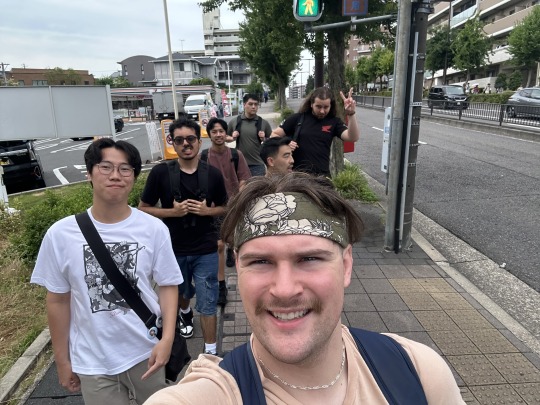
This is a picture of me and my dorm-mates walking to our first class together.
Intro to Japanese has been nothing but spectacular. Although the class is moving a bit slower I have chances everyday to practice what I learn so I am getting quite confident in my abilities. Also the teachers are so nice and helpful in class even though they do not speak almost any English.
In the afternoons we have Automotive Engineering class, now these are the tough ones. Having a 4 hour lecture every afternoon is not for the weak. What is entertaining though is the people the University bring in to special lectures. We have met employees from Nissan, Toyota, Mitsubishi and more. All of them gave given us amazing lectures on the future plans for these companies and what to expect if we ever end up working there. All of the lectures have been passionate to a point I have never experienced in the United States, everyone truly seems to love what they are doing and it makes the class so much more fun.
With about 5-6 hours of lecture a day I will at least concede the point that the amount of homework we have is light, often only a one page reflection on the information e learned, which is quite nice as I often find myself exploring in the afternoon/night with friends.
Another huge upside of this school is the cafeteria, the food is absolutely wonderful and dirt cheap:


Two of the lunches I've had. On the left a spicy miso ramen and I do not quite remember what the ride noodle bowl was called but it was equally delicious. Both of these cost me about $3 USD and they were amazing.
This first week we also had special tours of a number of different research labs here at Nagoya University.


These are two concept cars designed and created within the university. On the left you can see a small Toyota fitted with lidar and camera sensors, this is one of the universities forefront autonomously driven vehicles. On the right is a built from scratch "Slocal' (A slow locally driven vehicle which often gives verbal directions to the driver) vehicle which has the primary purpose of helping the elderly get around safely.

In addition to the research cars they have multiple highly technical driving simulators used for the research. These things are crazy big and so cool. I was even able to drive in one of them for a short while and the amount of modifications that are available via. software editing is ridiculous.
That was about it in terms of the technical knowledge and class stuff for this week so now we get to FOOD REVIEWS!!!!! <3
After being in Japan for over a week at this point I still had yet to have sushi so me and my roommates went and found this little hole in the wall place.


You can see me and my friends sitting at the bar on the left and the finished food spread on the right. We were the only ones in here for dinner which made sense as the sign outside only said すし which just translates to sushi (So still don't know the name of this place). We had an amazing time and the food was great and we even talked to the chef a bit in Japanese.
Around midweek I was craving something super spicy, and my girlfriend Olivia recommended me aa curry chain before I left called Coco Ichiban so we tried it out

This is the spread of each of our orders. Mine is in the bottom left (The one that is several shades darker than the others) I did not understand how the spice level system worked here and ordered a level 8. It turned out that meant it was about 24 times spicier than level 1. My spice cravings were definitely satisfied and then some. Still we had an amazing dinner and I do want to go back to try the level 10.
The next spot also came recommended from Olivia and it was a cream puff spot called Beard Papa.

This is a photo of all of their types of cream puffs. I got three different kinds: vanilla, peach, and green tea filling all with the original pastry. They were rich, decadent, and sweet; Everything you could want in a cream puff. (My favorite was the peach)
Lastly I did just a little bit of sightseeing towards the end of the week.

This is me at a Chunichi Dragons baseball game. Baseball is huge in Japan and this is the local Nagoya team. This night they won 1-0 against the Hiroshima Carp. The energy was super high the entire game, fans constantly cheering, music playing, it was so much fun. (I ended up buying a jersey because the starting pitcher did so well).
I have felt so much more comfortable in my surroundings this week and cannot wait to keep learning about and exploring this amazing country.
Until next time, さようなら, また 来週
Connor Gilfillan
Mechanical Engineering
NUSIP Automotive Engineering in Nagoya, Japan
2 notes
·
View notes
Quote
The official poverty measure is what’s sometimes known as an “absolute” poverty measure. Measures like this generally only adjust their thresholds for inflation. Many are based on less arbitrary numbers than “what people spent on food in 1955,” and many use different measurements of inflation, since a lot of economists think the Consumer Price Index overstates price increases compared to the Personal Consumption Expenditures (PCE) or chained CPI measures. But they fundamentally have a lot in common with the OPM’s approach: They set a dollar threshold for who is and isn’t poor and stick to it. Absolute poverty measures are crystal clear about what has happened to poverty since the 1960s: It plummeted. The below chart shows three different absolute measures, all of which use expansive income definitions, unlike the official rate. All three have fallen dramatically. The primary case for absolute measures like these is that they’re easy to interpret. Because the thresholds only change due to inflation, changes in the poverty rate only happen because people near the bottom get richer or poorer. If poverty falls, it’s because some low-income people gained more money or resources. If it increases, it’s because some low-income people lost out. Insofar as those kinds of material changes at the bottom are the main thing one cares about, absolute measures can be helpful. As a group of Columbia researchers argued in 2016, absolute measures are “more useful for establishing how families’ resources have changed against a fixed benchmark.” Applied to the US, the takeaway is that many fewer people are living on a very small amount of money than was the case in the 1960s. But many poverty scholars prefer to use what are called “relative” measures. Such measures set the threshold as a percentage of the country in question’s median income (usually 50 or 60 percent). Most rich countries other than the US define poverty in this way. The European Union, for instance, uses what it calls an “at risk of poverty” rate, defined as the share of residents in a country living on less than 60 percent of the median disposable income. The United Kingdom uses a “households below average income” (HBAI) statistic, with the main threshold set to 60 percent of median income. The case for relative measures is that poverty is socially defined, and “being in poverty” is usually thought of as people not being able to exist with the level of comfort that is normal in the society in which they live. A common definition, from the British scholar Peter Townsend, posits that poverty is “the absence or inadequacy of those diets, amenities, standards, services and activities which are common or customary in society.” Commonness or customariness are relative attributes, not absolute ones. Some, like sociologist David Brady, have also argued for relative measures on the grounds that they correlate better with self-reported mental and physical health and well-being. Looked at in relative terms, poverty hasn’t fallen in the US in recent decades. It’s stagnated.
“Why even brilliant scholars misunderstand poverty in America” from Vox
#reading list#vox#matthew desmond#poverty#measurement#government#welfare#absolute poverty#relative poverty
5 notes
·
View notes
Photo
youtube
How Wolves Change Rivers
When wolves were reintroduced to Yellowstone National Park in the United States after being absent nearly 70 years, the most remarkable "trophic cascade" occurred. What is a trophic cascade and how exactly do wolves change rivers? George Monbiot explains.
One of the most exciting scientific findings of the past half century has been the discovery of widespread trophic cascades. A trophic cascade is an ecological process which starts at the top of the food chain and tumbles all the way down to the bottom. And the classic example is what happened in the Yellowstone National Park in the United States when wolves were reintroduced in 1995. Now, we – we all know that wolves kill various species of animals, but perhaps we’re slightly less aware that they give life to many others.









219K notes
·
View notes
Text





(from top to bottom left to right: Imperial Palace, Yasakuni Shrine, Ichiran Ramen, View from elevator of Shibuya Sky, coffee that I got at imperial palace that I had high hopes for but was dissapointed [it just tasted like normal coffee])
May 9 - Imperial Palace, Yasakuni Shrine, Shibuya Sky
Today we started the day by visiting the Imperial Palace where we learned about the design of the moats, bridges, and gates and how all three elements worked together to produce a very well-defended structure. If an army was trying to invade the palace, the only way they would be able to go was through the multiple choke points created by the gates and sharp angles of the bridges. They could not go any other way because of the moat and very steep walls made from massive, virtually immoveable stones. You cannot go into any of the palace buildings but you can walk around the gardens, which were very pretty and had the most beautiful Koi I have ever seen in my life. After the palace, we walked to Yasukuni Shrine which is a very contentious site in Japan because there are war criminals enshrined there and many do not believe these war criminals should be honored by being left at the shrine. After Yasukuni we took the train back to Shibuya where we ate at Ichiran Ramen which was very cool and extremely good, then we shopped around and I bought some Adidas shoes and a shirt. I also decided randomly to do the Shibuya Sky lookout tower which was super cool because I got to see a different angle of the Shibuya crossing and I could see the mountains way better from that POV. I tried to find a mochi place but all the ones the internet suggested were closed by the time I was looking (about 6pm) which was shocking to me because it wasn't late at all but I guess mochi places just don't stay open very late.
Academic Reflection
After reading the two farming articles, I found it alarming that Japan has such an issue with low domestic production of food. A quick Google Search told me that Japan imports around 60% of all the food they consume. If this was true about the United States I would be very concerned about the immediate future of the country. That being said, I understand that Japan is a small country and much of it is now covered in concrete jungle, but having to rely on outside sources for 60% of your food seems like a dangerous game to play, especially after the COVID pandemic when it became clear that global supply chains are quite fragile and vulnerable to collapse from many different angles. I understand that the government is taking measures to address this low yield, but the situation seems quite precarious to me.
0 notes
Text
petriichvrs asked: 👪 & ❌ & 🌱 for millicent.

what is your muse’s relationship with their parents like? was it always this way?
rough! which somehow feels both accurate and a vast understatement all at the same time. growing up, millicent was a herrera rather than a bulstrode. before they were separated, the family were never … particularly strong as a unit parent - wise. parenthood never came naturally to their father, eduardo, and the larger family grew, the less he came home. millie thinks they remember their mom trying, but she leaned heavily on eldest child for support, which created an odd dynamic between them; hard to be told what to do by someone who treated you like an adult when it suited them, but they at least had some semblance of a relationship. a partnership almost, working together to cook, clean, etc. i think the fact they all lived as muggles due to eduardo being unaware of his wife & children’s status cemented them closer in a sense. they didn’t have as much possibility as the wix world will later offer. as an adult, however, millie has little to do with either parent. eduardo is a non - existence figure to her, his memories wiped when he risked the exposure of magic after discovering the truth. millie sometimes thinks his overreaction to them being wix was less about them being the devil like he claimed & more about him finally seeing an opportunity to leave what was already a sinking ship to him. she pretends not to think of him often, but knows his exact location at all times in an odd act of self - preservation. her mom, ingrid, never really recovered from his departure, leaving millie to pick up the slack with their siblings. this changed their dynamic completely. they stopped working together and millie, now back to being a disgraced bulstrode, grew to resent their mom. at some point, once all the kids were in hogwarts, ingrid bailed. she re - appears every now & then for money, which millie pays, but it isn’t … out of a sense of duty, rather a small cost to pay to keep her away. with all that in mind, there really is no relationship between millie and their parents, but at the same time? those relationships have shaped them into exactly who they are today. their personality is a perfect rebellion against their parents, intent on being everything they weren’t, so in a way? she has a more active relationship with them than she even realises.
is there something your muse struggles with that they might never overcome? what is it? why do they have so much trouble with it?
millie suffers from a big - time inferiority complex that they are highly unlikely to ever shake, even if they don’t acknowledge it. from birth, a whole half of her family ( the bulstrodes ) decided they weren’t worthy, simply for the fact her mom chose to have a relationship with a muggle. and that just kinda stuck. the family were never wealthy or well - off, they weren’t invited places other slytherin peers gushed about. the family in general were very much viewed as … the bottom of the food chain, so to speak. for someone so independent & confident as an adult, that rejection left a very, very bitter taste in millicent’s mouth, and a lot of their drive now comes from overriding that. they’re set on making sure nobody ever forgets their name. that they’re not out of place when they attend ministry galas, or an unknown figure when out with friends, and for the most part, they succeed. they don’t necessarily seek validation, but they definitely seek something and the problem is, i’m not sure they really know what it is they’re seeking, so they’re probably never gonna find it!
what themes are relevant to your muse?
i didn’t completely understand this question at first, so i’m winging this a bit! but themes or aesthetics i directly link to millicent are; a phoenix rising again from the ashes, always able to seize the opportunity to re - invent oneself / a longing for something they’ve never had, and therefore never really knowing what it is they’re even longing / rags to riches, bathing in the wealth they’ve bestowed upon themselves after clawing & scraping to get by / i did something bad by taylor swift. that’s it, that’s the theme / fighting. millicent has been throwing their entire weight into battle long before people paid them to do so as a career. / you make your own fate, one - sided coin type of vibes. the belief that your life isn’t already decided for you / a weird comfortability with murder & how to get away with it! everybody deserves a hobby, they say. / oddities. i think that’s the best way to describe millicent’s theme. they’re odd, they’re weird, and they embrace it. they’ve let it shape them rather than pretending to fit the mould.
1 note
·
View note
Text
Keeping it real... if you want more facts let me know..
America gained 7 million new jobs – more than three times government experts’ projections.
Middle-Class family income increased nearly $6,000 – more than five times the gains during the entire previous administration.
The unemployment rate reached 3.5 percent, the lowest in a half-century.
Achieved 40 months in a row with more job openings than job-hirings.
More Americans reported being employed than ever before – nearly 160 million.
Jobless claims hit a nearly 50-year low.
The number of people claiming unemployment insurance as a share of the population hit its lowest on record.
Incomes rose in every single metro area in the United States for the first time in nearly 3 decades.
Delivered a future of greater promise and opportunity for citizens of all backgrounds.
Unemployment rates for African Americans, Hispanic Americans, Asian Americans, Native Americans, veterans, individuals with disabilities, and those without a high school diploma all reached record lows.
Unemployment for women hit its lowest rate in nearly 70 years.
Lifted nearly 7 million people off of food stamps.
Poverty rates for African Americans and Hispanic Americans reached record lows.
Income inequality fell for two straight years, and by the largest amount in over a decade.
The bottom 50 percent of American households saw a 40 percent increase in net worth.
Wages rose fastest for low-income and blue collar workers – a 16 percent pay increase.
African American homeownership increased from 41.7 percent to 46.4 percent.
Brought jobs, factories, and industries back to the USA.
Created more than 1.2 million manufacturing and construction jobs.
Put in place policies to bring back supply chains from overseas.
Small business optimism broke a 35-year old record in 2018.
Hit record stock market numbers and record 401ks.
The DOW closed above 20,000 for the first time in 2017 and topped 30,000 in 2020.
The S&P 500 and NASDAQ have repeatedly notched record highs.
Rebuilding and investing in rural America.
Signed an Executive Order on Modernizing the Regulatory Framework for Agricultural Biotechnology Products, which is bringing innovative new technologies to market in American farming and agriculture.
Strengthened America’s rural economy by investing over $1.3 billion through the Agriculture Department’s ReConnect Program to bring high-speed broadband infrastructure to rural America.
Achieved a record-setting economic comeback by rejecting blanket lockdowns.
An October 2020 Gallup survey found 56 percent of Americans said they were better off during a pandemic than four years prior.
During the third quarter of 2020, the economy grew at a rate of 33.1 percent – the most rapid GDP growth ever recorded.
Since coronavirus lockdowns ended, the economy has added back over 12 million jobs, more than half the jobs lost.
Jobs have been recovered 23 times faster than the previous administration’s recovery.
Unemployment fell to 6.7 percent in December, from a pandemic peak of 14.7 percent in April – beating expectations of well over 10 percent unemployment through the end of 2020.
Under the previous administration, it took 49 months for the unemployment rate to fall from 10 percent to under 7 percent compared to just 3 months for the Trump Administration.
Since April, the Hispanic unemployment rate has fallen by 9.6 percent, Asian-American unemployment by 8.6 percent, and Black American unemployment by 6.8 percent.
80 percent of small businesses are now open, up from just 53 percent in April.
Small business confidence hit a new high.
Homebuilder confidence reached an all-time high, and home sales hit their highest reading since December 2006.
Manufacturing optimism nearly doubled.
Household net worth rose $7.4 trillion in Q2 2020 to $112 trillion, an all-time high.
Home prices hit an all-time record high.
The United States rejected crippling lockdowns that crush the economy and inflict countless public health harms and instead safely reopened its economy.
Business confidence is higher in America than in any other G7 or European Union country.
Stabilized America’s financial markets with the establishment of a number of Treasury Department supported facilities at the Federal Reserve.
Tax Relief for the Middle Class
Passed $3.2 trillion in historic tax relief and reformed the tax code.
Signed the Tax Cuts and Jobs Act – the largest tax reform package in history.
More than 6 million American workers received wage increases, bonuses, and increased benefits thanks to the tax cuts.
A typical family of four earning $75,000 received an income tax cut of more than $2,000 – slashing their tax bill in half.
Doubled the standard deduction – making the first $24,000 earned by a married couple completely tax-free.
Doubled the child tax credit.
Virtually eliminated the unfair Estate Tax, or Death Tax.
Cut the business tax rate from 35 percent – the highest in the developed world – all the way down to 21 percent.
Small businesses can now deduct 20 percent of their business income.
Businesses can now deduct 100 percent of the cost of their capital investments in the year the investment is made.
Since the passage of tax cuts, the share of total wealth held by the bottom half of households has increased, while the share held by the top 1 percent has decreased.
Over 400 companies have announced bonuses, wage increases, new hires, or new investments in the United States.
Over $1.5 trillion was repatriated into the United States from overseas.
Lower investment cost and higher capital returns led to faster growth in the middle class, real wages, and international competitiveness.
Jobs and investments are pouring into Opportunity Zones.
Created nearly 9,000 Opportunity Zones where capital gains on long-term investments are taxed at zero.
Opportunity Zone designations have increased property values within them by 1.1 percent, creating an estimated $11 billion in wealth for the nearly half of Opportunity Zone residents who own their own home.
Opportunity Zones have attracted $75 billion in funds and driven $52 billion of new investment in economically distressed communities, creating at least 500,000 new jobs.
Approximately 1 million Americans will be lifted from poverty as a result of these new investments.
Private equity investments into businesses in Opportunity Zones were nearly 30 percent higher than investments into businesses in similar areas that were not designated Opportunity Zones.
Massive Deregulation
Ended the regulatory assault on American Businesses and Workers.
Instead of 2-for-1, we eliminated 8 old regulations for every 1 new regulation adopted.
Provided the average American household an extra $3,100 every year.
Reduced the direct cost of regulatory compliance by $50 billion, and will reduce costs by an additional $50 billion in FY 2020 alone.
Removed nearly 25,000 pages from the Federal Register – more than any other president. The previous administration added over 16,000 pages.
Established the Governors’ Initiative on Regulatory Innovation to reduce outdated regulations at the state, local, and tribal levels.
Signed an executive order to make it easier for businesses to offer retirement plans.
Signed two executive orders to increase transparency in Federal agencies and protect Americans and their small businesses from administrative abuse.
Modernized the National Environmental Policy Act (NEPA) for the first time in over 40 years.
Reduced approval times for major infrastructure projects from 10 or more years down to 2 years or less.
Helped community banks by signing legislation that rolled back costly provisions of Dodd-Frank.
Established the White House Council on Eliminating Regulatory Barriers to Affordable Housing to bring down housing costs.
Removed regulations that threatened the development of a strong and stable internet.
Eased and simplified restrictions on rocket launches, helping to spur commercial investment in space projects.
Published a whole-of-government strategy focused on ensuring American leadership in automated vehicle technology.
Streamlined energy efficiency regulations for American families and businesses, including preserving affordable lightbulbs, enhancing the utility of showerheads, and enabling greater time savings with dishwashers.
Removed unnecessary regulations that restrict the seafood industry and impede job creation.
Modernized the Department of Agriculture’s biotechnology regulations to put America in the lead to develop new technologies.
Took action to suspend regulations that would have slowed our response to COVID-19, including lifting restrictions on manufacturers to more quickly produce ventilators.
Successfully rolled back burdensome regulatory overreach.
Rescinded the previous administration’s Affirmatively Furthering Fair Housing (AFFH) rule, which would have abolished zoning for single-family housing to build low-income, federally subsidized apartments.
Issued a final rule on the Fair Housing Act’s disparate impact standard.
Eliminated the Waters of the United States Rule and replaced it with the Navigable Waters Protection Rule, providing relief and certainty for farmers and property owners.
Repealed the previous administration’s costly fuel economy regulations by finalizing the Safer Affordable Fuel Efficient (SAFE) Vehicles rule, which will make cars more affordable, and lower the price of new vehicles by an estimated $2,200.
Americans now have more money in their pockets.
Deregulation had an especially beneficial impact on low-income Americans who pay a much higher share of their incomes for overregulation.
Cut red tape in the healthcare industry, providing Americans with more affordable healthcare and saving Americans nearly 10 percent on prescription drugs.
Deregulatory efforts yielded savings to the medical community an estimated $6.6 billion – with a reduction of 42 million hours of regulatory compliance work through 2021.
Removed government barriers to personal freedom and consumer choice in healthcare.
Once fully in effect, 20 major deregulatory actions undertaken by the Trump Administration are expected to save American consumers and businesses over $220 billion per year.
Signed 16 pieces of deregulatory legislation that will result in a $40 billion increase in annual real incomes.
Fair and Reciprocal Trade
Secured historic trade deals to defend American workers.
Immediately withdrew from the job-killing Trans-Pacific Partnership (TPP).
Ended the North American Free Trade Agreement (NAFTA), and replaced it with the brand new United States-Mexico-Canada Agreement (USMCA).
The USMCA contains powerful new protections for American manufacturers, auto-makers, farmers, dairy producers, and workers.
The USMCA is expected to generate over $68 billion in economic activity and potentially create over 550,000 new jobs over ten years.
Signed an executive order making it government policy to Buy American and Hire American, and took action to stop the outsourcing of jobs overseas.
Negotiated with Japan to slash tariffs and open its market to $7 billion in American agricultural products and ended its ban on potatoes and lamb.
Over 90 percent of American agricultural exports to Japan now receive preferential treatment, and most are duty-free.
Negotiated another deal with Japan to boost $40 billion worth of digital trade.
Renegotiated the United States-Korea Free Trade Agreement, doubling the cap on imports of American vehicles and extending the American light truck tariff.
Reached a written, fully-enforceable Phase One trade agreement with China on confronting pirated and counterfeit goods, and the protection of American ideas, trade secrets, patents, and trademarks.
China agreed to purchase an additional $200 billion worth of United States exports and opened market access for over 4,000 American facilities to exports while all tariffs remained in effect.
Achieved a mutual agreement with the European Union (EU) that addresses unfair trade practices and increases duty-free exports by 180 percent to $420 million.
Secured a pledge from the EU to eliminate tariffs on American lobster – the first United States-European Union negotiated tariff reduction in over 20 years.
Scored a historic victory by overhauling the Universal Postal Union, whose outdated policies were undermining American workers and interests.
Engaged extensively with trade partners like the EU and Japan to advance reforms to the World Trade Organization (WTO).
Issued a first-ever comprehensive report on the WTO Appellate Body’s failures to comply with WTO rules and interpret WTO agreements as written.
Blocked nominees to the WTO’s Appellate Body until WTO Members recognize and address longstanding issues with Appellate Body activism.
Submitted 5 papers to the WTO Committee on Agriculture to improve Members’ understanding of how trade policies are implemented, highlight areas for improved transparency, and encourage members to maintain up-to-date notifications on market access and domestic support.
Took strong actions to confront unfair trade practices and put America First.
Imposed tariffs on hundreds of billions worth of Chinese goods to protect American jobs and stop China’s abuses under Section 232 of the Trade Expansion Act of 1962 and Section 301 of the Trade Act of 1974.
Directed an all-of-government effort to halt and punish efforts by the Communist Party of China to steal and profit from American innovations and intellectual property.
Imposed tariffs on foreign aluminum and foreign steel to protect our vital industries and support our national security.
Approved tariffs on $1.8 billion in imports of washing machines and $8.5 billion in imports of solar panels.
Blocked illegal timber imports from Peru.
Took action against France for its digital services tax that unfairly targets American technology companies.
Launched investigations into digital services taxes that have been proposed or adopted by 10 other countries.
Historic support for American farmers.
Successfully negotiated more than 50 agreements with countries around the world to increase foreign market access and boost exports of American agriculture products, supporting more than 1 million American jobs.
Authorized $28 billion in aid for farmers who have been subjected to unfair trade practices – fully funded by the tariffs paid by China.
China lifted its ban on poultry, opened its market to beef, and agreed to purchase at least $80 billion of American agricultural products in the next two years.
The European Union agreed to increase beef imports by 180 percent and opened up its market to more imports of soybeans.
South Korea lifted its ban on American poultry and eggs, and agreed to provide market access for record exports of American rice.
Argentina lifted its ban on American pork.
Brazil agreed to increase wheat imports by $180 million a year and raised its quotas for purchases of United States ethanol.
Guatemala and Tunisia opened up their markets to American eggs.
Won tariff exemptions in Ecuador for wheat and soybeans.
Suspended $817 million in trade preferences for Thailand under the Generalized System of Preferences (GSP) program due to its failure to adequately provide reasonable market access for American pork products.
The amount of food stamps redeemed at farmers markets increased from $1.4 million in May 2020 to $1.75 million in September 2020 – a 50 percent increase over last year.
Rapidly deployed the Coronavirus Food Assistance Program, which provided $30 billion in support to farmers and ranchers facing decreased prices and market disruption when COVID-19 impacted the food supply chain.
Authorized more than $6 billion for the Farmers to Families Food Box program, which delivered over 128 million boxes of locally sourced, produce, meat, and dairy products to charity and faith-based organizations nationwide.
Delegated authorities via the Defense Production Act to protect breaks in the American food supply chain as a result of COVID-19.
American Energy Independence
Unleashed America’s oil and natural gas potential.
For the first time in nearly 70 years, the United States has become a net energy exporter.
The United States is now the number one producer of oil and natural gas in the world.
Natural gas production reached a record-high of 34.9 quads in 2019, following record high production in 2018 and in 2017.
The United States has been a net natural gas exporter for three consecutive years and has an export capacity of nearly 10 billion cubic feet per day.
Withdrew from the unfair, one-sided Paris Climate Agreement.
Canceled the previous administration’s Clean Power Plan, and replaced it with the new Affordable Clean Energy rule.
Approved the Keystone XL and Dakota Access pipelines.
Opened up the Arctic National Wildlife Refuge (ANWR) in Alaska to oil and gas leasing.
Repealed the last administration’s Federal Coal Leasing Moratorium, which prohibited coal leasing on Federal lands.
Reformed permitting rules to eliminate unnecessary bureaucracy and speed approval for mines.
Fixed the New Source Review permitting program, which punished companies for upgrading or repairing coal power plants.
Fixed the Environmental Protection Agency’s (EPA) steam electric and coal ash rules.
The average American family saved $2,500 a year in lower electric bills and lower prices at the gas pump.
Signed legislation repealing the harmful Stream Protection Rule.
Reduced the time to approve drilling permits on public lands by half, increasing permit applications to drill on public lands by 300 percent.
Expedited approval of the NuStar’s New Burgos pipeline to export American gasoline to Mexico.
Streamlined Liquefied natural gas (LNG) terminal permitting and allowed long-term LNG export authorizations to be extended through 2050.
The United States is now among the top three LNG exporters in the world.
Increased LNG exports five-fold since January 2017, reaching an all-time high in January 2020.
LNG exports are expected to reduce the American trade deficit by over $10 billion.
Granted more than 20 new long-term approvals for LNG exports to non-free trade agreement countries.
The development of natural gas and LNG infrastructure in the United States is providing tens of thousands of jobs, and has led to the investment of tens of billions of dollars in infrastructure.
There are now 6 LNG export facilities operating in the United States, with 2 additional export projects under construction.
The amount of nuclear energy production in 2019 was the highest on record, through a combination of increased capacity from power plant upgrades and shorter refueling and maintenance cycles.
Prevented Russian energy coercion across Europe through various lines of effort, including the Partnership for Transatlantic Energy Cooperation, civil nuclear deals with Romania and Poland, and opposition to Nord Stream 2 pipeline.
Issued the Presidential Permit for the A2A railroad between Canada and Alaska, providing energy resources to emerging markets.
Increased access to our country’s abundant natural resources in order to achieve energy independence.
Renewable energy production and consumption both reached record highs in 2019.
Enacted policies that helped double the amount of electricity generated by solar and helped increase the amount of wind generation by 32 percent from 2016 through 2019.
Accelerated construction of energy infrastructure to ensure American energy producers can deliver their products to the market.
Cut red tape holding back the construction of new energy infrastructure.
Authorized ethanol producers to sell E15 year-round and allowed higher-ethanol gasoline to be distributed from existing pumps at filling stations.
Ensured greater transparency and certainty in the Renewable Fuel Standard (RFS) program.
Negotiated leasing capacity in the Strategic Petroleum Reserve to Australia, providing American taxpayers a return on this infrastructure investment.
To name a few....

1K notes
·
View notes
Text
The Advantages Of Plastic Packaging Pallets

Packaging Pallets plays a crucial role in today’s modern logistics. It pays to think long-term about what kind of pallet is ideal for all facets of your organization, as they are an essential component of any supply chain. Various materials, mainly wood and plastic, are used to make pallets, and almost every item you see in a store is transported on a pallet. Pallets come in a wide variety of materials, with wood and plastic being the most popular. Plastic pallets are made via plastic injection moulding, allowing durability and space-saving design.
You can carry everything from furniture to clothes using plastic pallets, whether relocating or intending to operate a business.
Choosing plastic pallets from printing and packaging plastic pallets manufacturers offers several benefits:-
Pallets made of plastic are simpler to move.
Plastic is more resilient than wood and is less prone to malfunction after several flights. Plastic pallets are also excellent for moving objects with a forklift in a warehouse and hauling extensive material during shipment. In addition, plastic pallets are better equipped to tolerate more extreme weather conditions while in transportation compared to wood pallets.
Plastic pallets are reasonably priced.
Whether you’re shipping products by land, sea, or air, freight costs are often less expensive when using plastic pallets than wooden ones. Plastic pallets frequently cost more upfront, but because of their longevity, the cost of each trip is frequently much lower. Recent technological advancements have reduced the price of plastic pallets.
Hygienic pallets made of plastic
Common problems with wood pallets, such as decay, infestation, fumigation, and smell absorption, are no longer a concern since plastic pallets do not absorb moisture. Because of this, cleaning plastic pallets’ flat surfaces after each usage is straightforward and comprehensive. Plastic pallets are ideal for businesses with strict regulations and cleanliness standards, such as the pharmaceutical and food and beverage sectors. Termites are drawn to wood, which is never good for a business that is shipping a lot of goods. Additionally, you don’t want germs or fungus to get onto your merchandise. On the other side, cleaning plastic pallets is a breeze. A quick water hose spray will do wonders for cleaning a plastic pallet. A wood pallet is more challenging to clean since termites and fungi grow on damp wood.
Plastic packaging pallets make everyone safer.
In contrast to wood pallets, plastic pallets don’t have weak points at specific locations. This results from how plastic pallets are made as single pieces. As a result, the likelihood of units collapsing under an oversized load is reduced. Nails, splinters, and broken boards are all avoided using plastic pallets rather than wooden ones. This denotes that your priceless items are less likely to be harmed, and the workplace is safer for your employees.
Plastic packaging pallets takes up less room.
The ability to nest plastic pallets gives them a significant advantage over wooden pallets. A nine-leg bottom is a common characteristic of nestable pallets, which may save valuable warehouse space by nesting into other pallets. Many businesses attempting to go green have made it one of their goals to produce less garbage. Plastic can be recycled entirely; plastic is reusable and can be recycled if something happens. Damaged wooden pallets are typically either dumped at a landfill or burnt.
More adaptable and versatile than wooden pallets
Plastic pallets come in various styles and can be utilized for multiple settings and objectives. They are more pliable and durable, may be created to meet the individual requirements of various industries, regardless of whether the majority of your operations occur in the warehouse or during export. Plastic pallets don’t contain splinters, as was already explained. Additionally, they lack sharp edges and nails. When goods are transported on wooden pallets, there is a greater danger of damage. Plastic pallets will efficiently and securely meet your transportation demands. Plastic pallets are more cost-effective since they are more space-efficient and more adaptable.
Wooden pallets survive less time than plastic ones.
When deciding between plastic and wood pallets, it’s a good idea to think about how you’ll use them. Purchasing pallets made for lifespan makes sense if you often ship goods or use them in a warehouse. Plastic pallets may be used repeatedly without suffering significant damage. By doing your part to remove garbage from the ecosystem rather than adding to it, you can fight the throwaway culture that fuels climate change and position your company on the right side of history.
Flexibility
Plastic is not only strong, but it is also flexible. It has the benefit of allowing various sizes and types of items to fit on a single pallet. Only one kind of item can be packed on a wooden pallet. Most plastic pallets come with dividers of different widths, making loading a wide range of things simple. Our plastic pallets and boxes are molded under intense pressure in highly polished molds for consistency, dimensional precision, and loading capabilities. When compared to wood, a plastic pallet has unmatched strength and durability. Heavy strength plastic pallets and boxes can resist demanding, closed-loop settings with high repetition.
Conclusion
Plastic pallets are known to survive almost ten times longer than wood as a company asset. Using a specific plastic pool pallet, an owned pallet pool may be built that can even produce its income, providing a significant return on investment. Because plastic packaging pallets are exempt from International Standards for Phytosanitary Measures No. 15 (ISPM15), which eliminates the requirement to heat treat and certify them for usage, they are cost-effective for export.
#swifttechnoplast#plastic industry#plasticmanufacturer#plasticpallets#hdpepallets#plasticproducts#hdpeplastic#swifttechnoplastprivatelimited#printing pallet#packaging pallet
0 notes
Text
New Post has been published on All about business online
New Post has been published on https://yaroreviews.info/2023/11/mcdonalds-faces-up-to-two-sex-abuse-claims-a-week
McDonald's faces up to two sex abuse claims a week
Getty Images
By Noor Nanji, Zoe Conway & Dearbail Jordan
BBC News
McDonald’s UK boss has admitted the fast-food chain is receiving between one or two sexual harassment claims a week following a BBC investigation.
Alistair Macrow told MPs it had received more than 400 complaints from workers since July, when the BBC uncovered hundreds of allegations.
He said 18 people had since been sacked but he did not know how many complaints had been referred to the police.
The BBC found that workers as young as 17 were being groped and harassed.
They said they experienced a toxic workplace culture at McDonald’s where claims of sexual assault, racism and bullying were not taken seriously.
Mr Macrow told the Business and Trade Select Committee on Tuesday that McDonald’s UK had received 407 employee complaints of a varying nature since July.
Following the BBC’s initial report in the summer, Mr Macrow set up an investigation handling unit to deal with complaints.
Of the 157 complaints that have been investigated, Mr Macrow said 17 complaints were about sexual harassment and had led to disciplinary action. He added that nine related to bullying and one was about racial harassment.
‘There’s disgusting behaviour at my McDonald’s’
McDonald’s abused workers told to come forward
McDonald’s workers speak out over sexual abuse claims
In relation to the outstanding cases yet to be probed, 27 complaints are about sexual harassment, he added.
Mr Macrow said: “To give you a picture of what we see on an ongoing basis, we typically would see between 20 to 25 contacts per week, of which one or two would be sexual harassment.”
The fast-food chain is one of the biggest private sector employers in the UK, employing more than 170,000 people.
It has one of the UK’s youngest workforces, with three quarters of staff aged 16 to 25 and, for many, it is their first job.
In total, it has 1,450 restaurants. According to Mr Macrow, 89% of its branches in the UK are operated by franchisees. But he admitted that no franchisees had yet lost their contracts due to claims of harassment and abuse.
‘Protecting workers’
Liam Byrne, chair of the Business and Trade Committee, asked the McDonald’s boss if “profit was more important than protecting workers”.
Mr Macrow said it was “absolutely not the case”.
“The most important thing in our business is our people. We do everything we can to look after our people,” he added.
More than 200 current and former McDonald’s workers spoke to the BBC about their experience of working at the fast-food chain, with a number claiming they were subject to sexual abuse and harassment by colleagues and superiors.
Among those was Ed and Emily, who both attended the committee hearing on Tuesday. They both said they did not feel reassured by what Mr Macrow said.
Emily was 17 when she got her first post-college job at a McDonald’s in north west England. She was groped and hit on the bottom by her manager. She reported him on the company’s staff support service but never received a reply.
She believes that Mr Macrow and McDonald’s does put profit before people.
“When I was working at McDonald’s it was very clear to me that I was easily replaceable,” she told the BBC. “I think that it’s definitely true that he has put profit before the people because as soon as I brought forth an allegation, I was fired.
“So it’s easier for them to just fire me than actually look into these allegations.”
Mr Macrow said the testimony from workers had been “truly horrific” and “very difficult to hear”.
He admitted that some of the complaints reported to McDonald’s independent handling unit “stretch back as far as the 1980s”, adding: “Clearly those more recent we were able to investigate more fully.”
Ed was 16 when he started working in McDonald’s at the beginning of this year. He said a senior manager made sexual innuendos and repeatedly asked him for sex. He raised it with a senior manager, but nothing was done.
Eventually, after months of harassment, he quit in April.
He said that hearing that more than 400 complaints had made to McDonald’s in the past four months “was quite shocking and upsetting and I think is damning evidence against McDonald’s that they need to change”.
But he added: “What you should be thinking about is how many people have been unable to make those complaints, who’ve been scared to complain, particularly to managers who will be controlling their hours.
“Who else is currently being harassed or going through something and is unable to come forward?”
Ian Hodson, national president at the Bakers, Food and Allied Workers Union, also appeared before MPs and said some stories that it had been told by McDonald’s employees were “absolutely horrific”.
“And it shouldn’t happen,” he said. “In the 21st century, in the UK, it shouldn’t happen.”
Mr Hodson added: “When a global corporation, [one of the] biggest employers in the world that makes billions and billions of pounds, can’t protect its workforce it’s awful. It should be leading and be an example for others – but they’re not.”
Have you been affected by issues covered in this story? You can share your experiences by emailing [email protected].
Please include a contact number if you are willing to speak to a BBC journalist. You can also get in touch in the following ways:
WhatsApp: +44 7756 165803
Tweet: @BBC_HaveYourSay
Upload pictures or video
Please read our terms & conditions and privacy policy
If you are reading this page and can’t see the form you will need to visit the mobile version of the BBC website to submit your question or comment or you can email us at [email protected]. Please include your name, age and location with any submission.
Related Topics
Companies
Sexual harassment
McDonald’s
More on this story
‘There’s disgusting behaviour at my McDonald’s’
5 days ago
McDonald’s abused workers told to come forward
19 July
McDonald’s workers speak out over sexual abuse claims
18 July
0 notes
Text
America gained 7 million new jobs – more than three times government experts’ projections.
Middle-Class family income increased nearly $6,000 – more than five times the gains during the entire previous administration.
The unemployment rate reached 3.5 percent, the lowest in a half-century.
Achieved 40 months in a row with more job openings than job-hirings.
More Americans reported being employed than ever before – nearly 160 million.
Jobless claims hit a nearly 50-year low.
The number of people claiming unemployment insurance as a share of the population hit its lowest on record.
Incomes rose in every single metro area in the United States for the first time in nearly 3 decades.
Delivered a future of greater promise and opportunity for citizens of all backgrounds.
Unemployment rates for African Americans, Hispanic Americans, Asian Americans, Native Americans, veterans, individuals with disabilities, and those without a high school diploma all reached record lows.
Unemployment for women hit its lowest rate in nearly 70 years.
Lifted nearly 7 million people off of food stamps.
Poverty rates for African Americans and Hispanic Americans reached record lows.
Income inequality fell for two straight years, and by the largest amount in over a decade.
The bottom 50 percent of American households saw a 40 percent increase in net worth.
Wages rose fastest for low-income and blue collar workers – a 16 percent pay increase.
African American homeownership increased from 41.7 percent to 46.4 percent.
Brought jobs, factories, and industries back to the USA.
Created more than 1.2 million manufacturing and construction jobs.
Put in place policies to bring back supply chains from overseas.
Small business optimism broke a 35-year old record in 2018.
Hit record stock market numbers and record 401ks.
The DOW closed above 20,000 for the first time in 2017 and topped 30,000 in 2020.
The S&P 500 and NASDAQ have repeatedly notched record highs.
Rebuilding and investing in rural America.
Signed an Executive Order on Modernizing the Regulatory Framework for Agricultural Biotechnology Products, which is bringing innovative new technologies to market in American farming and agriculture.
Strengthened America’s rural economy by investing over $1.3 billion through the Agriculture Department’s ReConnect Program to bring high-speed broadband infrastructure to rural America.
Achieved a record-setting economic comeback by rejecting blanket lockdowns.
An October 2020 Gallup survey found 56 percent of Americans said they were better off during a pandemic than four years prior.
During the third quarter of 2020, the economy grew at a rate of 33.1 percent – the most rapid GDP growth ever recorded.
Since coronavirus lockdowns ended, the economy has added back over 12 million jobs, more than half the jobs lost.
Jobs have been recovered 23 times faster than the previous administration’s recovery.
Unemployment fell to 6.7 percent in December, from a pandemic peak of 14.7 percent in April – beating expectations of well over 10 percent unemployment through the end of 2020.
Under the previous administration, it took 49 months for the unemployment rate to fall from 10 percent to under 7 percent compared to just 3 months for the Trump Administration.
Since April, the Hispanic unemployment rate has fallen by 9.6 percent, Asian-American unemployment by 8.6 percent, and Black American unemployment by 6.8 percent.
80 percent of small businesses are now open, up from just 53 percent in April.
Small business confidence hit a new high.
Homebuilder confidence reached an all-time high, and home sales hit their highest reading since December 2006.
Manufacturing optimism nearly doubled.
Household net worth rose $7.4 trillion in Q2 2020 to $112 trillion, an all-time high.
Home prices hit an all-time record high.
The United States rejected crippling lockdowns that crush the economy and inflict countless public health harms and instead safely reopened its economy.
Business confidence is higher in America than in any other G7 or European Union country.
Stabilized America’s financial markets with the establishment of a number of Treasury Department supported facilities at the Federal Reserve.
Tax Relief for the Middle Class
Passed $3.2 trillion in historic tax relief and reformed the tax code.
Signed the Tax Cuts and Jobs Act – the largest tax reform package in history.
More than 6 million American workers received wage increases, bonuses, and increased benefits thanks to the tax cuts.
A typical family of four earning $75,000 received an income tax cut of more than $2,000 – slashing their tax bill in half.
Doubled the standard deduction – making the first $24,000 earned by a married couple completely tax-free.
Doubled the child tax credit.
Virtually eliminated the unfair Estate Tax, or Death Tax.
Cut the business tax rate from 35 percent – the highest in the developed world – all the way down to 21 percent.
Small businesses can now deduct 20 percent of their business income.
Businesses can now deduct 100 percent of the cost of their capital investments in the year the investment is made.
Since the passage of tax cuts, the share of total wealth held by the bottom half of households has increased, while the share held by the top 1 percent has decreased.
Over 400 companies have announced bonuses, wage increases, new hires, or new investments in the United States.
Over $1.5 trillion was repatriated into the United States from overseas.
Lower investment cost and higher capital returns led to faster growth in the middle class, real wages, and international competitiveness.
Jobs and investments are pouring into Opportunity Zones.
Created nearly 9,000 Opportunity Zones where capital gains on long-term investments are taxed at zero.
Opportunity Zone designations have increased property values within them by 1.1 percent, creating an estimated $11 billion in wealth for the nearly half of Opportunity Zone residents who own their own home.
Opportunity Zones have attracted $75 billion in funds and driven $52 billion of new investment in economically distressed communities, creating at least 500,000 new jobs.
Approximately 1 million Americans will be lifted from poverty as a result of these new investments.
Private equity investments into businesses in Opportunity Zones were nearly 30 percent higher than investments into businesses in similar areas that were not designated Opportunity Zones.
Massive Deregulation
Ended the regulatory assault on American Businesses and Workers.
Instead of 2-for-1, we eliminated 8 old regulations for every 1 new regulation adopted.
Provided the average American household an extra $3,100 every year.
Reduced the direct cost of regulatory compliance by $50 billion, and will reduce costs by an additional $50 billion in FY 2020 alone.
Removed nearly 25,000 pages from the Federal Register – more than any other president. The previous administration added over 16,000 pages.
Established the Governors’ Initiative on Regulatory Innovation to reduce outdated regulations at the state, local, and tribal levels.
Signed an executive order to make it easier for businesses to offer retirement plans.
Signed two executive orders to increase transparency in Federal agencies and protect Americans and their small businesses from administrative abuse.
Modernized the National Environmental Policy Act (NEPA) for the first time in over 40 years.
Reduced approval times for major infrastructure projects from 10 or more years down to 2 years or less.
Helped community banks by signing legislation that rolled back costly provisions of Dodd-Frank.
Established the White House Council on Eliminating Regulatory Barriers to Affordable Housing to bring down housing costs.
Removed regulations that threatened the development of a strong and stable internet.
Eased and simplified restrictions on rocket launches, helping to spur commercial investment in space projects.
Published a whole-of-government strategy focused on ensuring American leadership in automated vehicle technology.
Streamlined energy efficiency regulations for American families and businesses, including preserving affordable lightbulbs, enhancing the utility of showerheads, and enabling greater time savings with dishwashers.
Removed unnecessary regulations that restrict the seafood industry and impede job creation.
Modernized the Department of Agriculture’s biotechnology regulations to put America in the lead to develop new technologies.
Took action to suspend regulations that would have slowed our response to COVID-19, including lifting restrictions on manufacturers to more quickly produce ventilators.
Successfully rolled back burdensome regulatory overreach.
Rescinded the previous administration’s Affirmatively Furthering Fair Housing (AFFH) rule, which would have abolished zoning for single-family housing to build low-income, federally subsidized apartments.
Issued a final rule on the Fair Housing Act’s disparate impact standard.
Eliminated the Waters of the United States Rule and replaced it with the Navigable Waters Protection Rule, providing relief and certainty for farmers and property owners.
Repealed the previous administration’s costly fuel economy regulations by finalizing the Safer Affordable Fuel Efficient (SAFE) Vehicles rule, which will make cars more affordable, and lower the price of new vehicles by an estimated $2,200.
Americans now have more money in their pockets.
Deregulation had an especially beneficial impact on low-income Americans who pay a much higher share of their incomes for overregulation.
Cut red tape in the healthcare industry, providing Americans with more affordable healthcare and saving Americans nearly 10 percent on prescription drugs.
Deregulatory efforts yielded savings to the medical community an estimated $6.6 billion – with a reduction of 42 million hours of regulatory compliance work through 2021.
Removed government barriers to personal freedom and consumer choice in healthcare.
Once fully in effect, 20 major deregulatory actions undertaken by the Trump Administration are expected to save American consumers and businesses over $220 billion per year.
Signed 16 pieces of deregulatory legislation that will result in a $40 billion increase in annual real incomes.
Fair and Reciprocal Trade
Secured historic trade deals to defend American workers.
Immediately withdrew from the job-killing Trans-Pacific Partnership (TPP).
Ended the North American Free Trade Agreement (NAFTA), and replaced it with the brand new United States-Mexico-Canada Agreement (USMCA).
The USMCA contains powerful new protections for American manufacturers, auto-makers, farmers, dairy producers, and workers.
The USMCA is expected to generate over $68 billion in economic activity and potentially create over 550,000 new jobs over ten years.
Signed an executive order making it government policy to Buy American and Hire American, and took action to stop the outsourcing of jobs overseas.
Negotiated with Japan to slash tariffs and open its market to $7 billion in American agricultural products and ended its ban on potatoes and lamb.
Over 90 percent of American agricultural exports to Japan now receive preferential treatment, and most are duty-free.
Negotiated another deal with Japan to boost $40 billion worth of digital trade.
Renegotiated the United States-Korea Free Trade Agreement, doubling the cap on imports of American vehicles and extending the American light truck tariff.
Reached a written, fully-enforceable Phase One trade agreement with China on confronting pirated and counterfeit goods, and the protection of American ideas, trade secrets, patents, and trademarks.
China agreed to purchase an additional $200 billion worth of United States exports and opened market access for over 4,000 American facilities to exports while all tariffs remained in effect.
Achieved a mutual agreement with the European Union (EU) that addresses unfair trade practices and increases duty-free exports by 180 percent to $420 million.
Secured a pledge from the EU to eliminate tariffs on American lobster – the first United States-European Union negotiated tariff reduction in over 20 years.
Scored a historic victory by overhauling the Universal Postal Union, whose outdated policies were undermining American workers and interests.
Engaged extensively with trade partners like the EU and Japan to advance reforms to the World Trade Organization (WTO).
Issued a first-ever comprehensive report on the WTO Appellate Body’s failures to comply with WTO rules and interpret WTO agreements as written.
Blocked nominees to the WTO’s Appellate Body until WTO Members recognize and address longstanding issues with Appellate Body activism.
Submitted 5 papers to the WTO Committee on Agriculture to improve Members’ understanding of how trade policies are implemented, highlight areas for improved transparency, and encourage members to maintain up-to-date notifications on market access and domestic support.
Took strong actions to confront unfair trade practices and put America First.
Imposed tariffs on hundreds of billions worth of Chinese goods to protect American jobs and stop China’s abuses under Section 232 of the Trade Expansion Act of 1962 and Section 301 of the Trade Act of 1974.
Directed an all-of-government effort to halt and punish efforts by the Communist Party of China to steal and profit from American innovations and intellectual property.
Imposed tariffs on foreign aluminum and foreign steel to protect our vital industries and support our national security.
Approved tariffs on $1.8 billion in imports of washing machines and $8.5 billion in imports of solar panels.
Blocked illegal timber imports from Peru.
Took action against France for its digital services tax that unfairly targets American technology companies.
Launched investigations into digital services taxes that have been proposed or adopted by 10 other countries.
Historic support for American farmers.
Successfully negotiated more than 50 agreements with countries around the world to increase foreign market access and boost exports of American agriculture products, supporting more than 1 million American jobs.
Authorized $28 billion in aid for farmers who have been subjected to unfair trade practices – fully funded by the tariffs paid by China.
China lifted its ban on poultry, opened its market to beef, and agreed to purchase at least $80 billion of American agricultural products in the next two years.
The European Union agreed to increase beef imports by 180 percent and opened up its market to more imports of soybeans.
South Korea lifted its ban on American poultry and eggs, and agreed to provide market access for record exports of American rice.
Argentina lifted its ban on American pork.
Brazil agreed to increase wheat imports by $180 million a year and raised its quotas for purchases of United States ethanol.
Guatemala and Tunisia opened up their markets to American eggs.
Won tariff exemptions in Ecuador for wheat and soybeans.
Suspended $817 million in trade preferences for Thailand under the Generalized System of Preferences (GSP) program due to its failure to adequately provide reasonable market access for American pork products.
The amount of food stamps redeemed at farmers markets increased from $1.4 million in May 2020 to $1.75 million in September 2020 – a 50 percent increase over last year.
Rapidly deployed the Coronavirus Food Assistance Program, which provided $30 billion in support to farmers and ranchers facing decreased prices and market disruption when COVID-19 impacted the food supply chain.
Authorized more than $6 billion for the Farmers to Families Food Box program, which delivered over 128 million boxes of locally sourced, produce, meat, and dairy products to charity and faith-based organizations nationwide.
Delegated authorities via the Defense Production Act to protect breaks in the American food supply chain as a result of COVID-19.
American Energy Independence
Unleashed America’s oil and natural gas potential.
For the first time in nearly 70 years, the United States has become a net energy exporter.
The United States is now the number one producer of oil and natural gas in the world.
Natural gas production reached a record-high of 34.9 quads in 2019, following record high production in 2018 and in 2017.
The United States has been a net natural gas exporter for three consecutive years and has an export capacity of nearly 10 billion cubic feet per day.
Withdrew from the unfair, one-sided Paris Climate Agreement.
Canceled the previous administration’s Clean Power Plan, and replaced it with the new Affordable Clean Energy rule.
Approved the Keystone XL and Dakota Access pipelines.
Opened up the Arctic National Wildlife Refuge (ANWR) in Alaska to oil and gas leasing.
Repealed the last administration’s Federal Coal Leasing Moratorium, which prohibited coal leasing on Federal lands.
Reformed permitting rules to eliminate unnecessary bureaucracy and speed approval for mines.
Fixed the New Source Review permitting program, which punished companies for upgrading or repairing coal power plants.
Fixed the Environmental Protection Agency’s (EPA) steam electric and coal ash rules.
The average American family saved $2,500 a year in lower electric bills and lower prices at the gas pump.
Signed legislation repealing the harmful Stream Protection Rule.
Reduced the time to approve drilling permits on public lands by half, increasing permit applications to drill on public lands by 300 percent.
Expedited approval of the NuStar’s New Burgos pipeline to export American gasoline to Mexico.
Streamlined Liquefied natural gas (LNG) terminal permitting and allowed long-term LNG export authorizations to be extended through 2050.
The United States is now among the top three LNG exporters in the world.
Increased LNG exports five-fold since January 2017, reaching an all-time high in January 2020.
LNG exports are expected to reduce the American trade deficit by over $10 billion.
Granted more than 20 new long-term approvals for LNG exports to non-free trade agreement countries.
The development of natural gas and LNG infrastructure in the United States is providing tens of thousands of jobs, and has led to the investment of tens of billions of dollars in infrastructure.
There are now 6 LNG export facilities operating in the United States, with 2 additional export projects under construction.
The amount of nuclear energy production in 2019 was the highest on record, through a combination of increased capacity from power plant upgrades and shorter refueling and maintenance cycles.
Prevented Russian energy coercion across Europe through various lines of effort, including the Partnership for Transatlantic Energy Cooperation, civil nuclear deals with Romania and Poland, and opposition to Nord Stream 2 pipeline.
Issued the Presidential Permit for the A2A railroad between Canada and Alaska, providing energy resources to emerging markets.
Increased access to our country’s abundant natural resources in order to achieve energy independence.
Renewable energy production and consumption both reached record highs in 2019.
Enacted policies that helped double the amount of electricity generated by solar and helped increase the amount of wind generation by 32 percent from 2016 through 2019.
Accelerated construction of energy infrastructure to ensure American energy producers can deliver their products to the market.
Cut red tape holding back the construction of new energy infrastructure.
Authorized ethanol producers to sell E15 year-round and allowed higher-ethanol gasoline to be distributed from existing pumps at filling stations.
Ensured greater transparency and certainty in the Renewable Fuel Standard (RFS) program.
Negotiated leasing capacity in the Strategic Petroleum Reserve to Australia, providing American taxpayers a return on this infrastructure investment.

1K notes
·
View notes
Text
Before the Devildom
It was small, this life Elaine had now. It was something that could easily fade into the background of the bustling area she had started living in. But it was far, far preferred to what had gripped her five months before, robbed her of breath and chained her limbs. Freedom of choice, mobility, identity, all hers for the first time.
Elaine loved the tiny studio apartment with scarce furniture, peeling wallpaper, and non-existent heating. She loved her thrift shop-scrounged wardrobe, the main articles of clothing being jeans, sweatpants, t-shirts, hoodies, and a couple pairs of slacks and spotless button-ups. No dresses allowed, nor skirts or frills or fake pockets. All of her selections were practical and comfortable.
Her kitchen--her very own kitchen!--with enough food to last her weeks all handpicked by herself at the nearby supermarket. Box mac n cheese, instant ramen, canned soups, saltines, cornbread box mix, grits, rice, and dried oregano lined her pantry, while frozen veggies, whole milk, salted butter (so much salted butter!), and sealed jars of sofrito inhabited the noisily rumbling fridge.
Elaine now maintained an administrative job working the front desk of an IT company, taking phone calls and greeting the people who walked by the desk, attempting to coordinate meetings for her boss, a middle-aged man who barely looked at her yet spoke politely enough. Updating her resume for the first time in years had been a slight struggle, but a welcome one, as was the interview process and the first week of trial-and-error training on the clock. She had her own key to her apartment and set her own hours of operation outside of work. She could easily walk to the bank (to steadily build her growing savings account) or the pharmacy (with access to anti-depressants). She practiced yoga in the morning and occasionally in the evenings. She drank tea with honey coating the bottom of the mug and took coffee with cream and sugar. She asked permission for none of her activities. Not a single one.
On rainy weekends, when Elaine had the day to herself, she would sit with a mug of white coffee and watch life through the veil of precipitation from her tiny second-floor balcony.
The Bavarian oma who lived above Elaine's unit had two cats that were often accidentally locked outdoors. As a result, they clambered down the fire escape and found refuge on Elaine's relatively dry balcony. Their collars read Felix and Minka.
Felix was a handsome auburn Abyssinian with enormous green eyes that observed the movement of everything, while Minka was a dignified Himalayan who preferred lounging on Elaine's lap and peering judgmentally at her counterpart. Elaine had begun buying cans of discount cat food or (when pet food was not on sale and priced far too high for her budget) cans of tuna to have on hand for the duo's anticipated visits.
Some mornings, when she awoke, it would take her a moment or two to recognize where she was. The realization was overwhelming, but sweet and welcome. Early on, there were times when she would realize that she was hungry, but automatically hang back, thinking to herself that she couldn't go to the pantry.
'Why? And who on earth would I ask?' she would rationalize. 'I'm hungry and there's no need to ask permission for anything.' As days turned to weeks, this psychological reflex occurred less and less, though there was no denying that it still happened occasionally. Months went by and it was almost gone entirely.
Elaine had always been a heavy sleeper, often joking that not even an earthquake could rouse her, but her eyes flew open when there was a loud crash. The little alarm clock on her nightstand read that it was nearly midnight. She sat up, adrenaline flooding through her veins, and swung her legs out of bed. She had recently purchased a baseball bat to keep by her bedside for self-defense and her knuckles went white as she gripped the hefty stick. She rose from the bed, careful to avoid the aged floorboards here and there that would undoubtedly give her away, and approached her bedroom door.
The door opened quietly enough and she peered around the corner into the main area of the apartment. In the silver moonlight flooding through the windows, she spotted one of the cat's bowls lying beneath the windowsill that lead out to her little balcony, upside down and dark little spots that could only have been Kitty Kibble scattered across the floor. A soft breeze wafted through the open window, only two or three inches open, and shifted the curtains.
Elaine's grip on the bat relaxed. One of the cats had simply wanted a midnight snack, she reasoned. Her heart rate begin to slow from relief and the bat lowered as she chuckled to herself.
There was what felt like a forceful shove or a sharp punch in the center of her back.
A tingling sensation in the center of her upper back spread deeper, coiling through her muscles and bones. It had a form. Slowly, Elaine's eyes drifted downward. There was a tiny tenting in her shirt, something newly sprouted from her chest. In the dim light of the apartment, Elaine saw a dark splotch on her shirt, the size of a cherry, grow larger. Darker. She knew what it was, but felt no fear nor despair. She felt serene, weightless. In a strange way, the growing splotch was hypnotizing, drawing her vision deeper into abyss. The last thing Elaine heard before her consciousness turned inward and she fell forward was a huff of breath from behind.
"After all that I did for you... you would really leave me? Just like that?" He stood over her limp form. "I was only trying to help you, protect you. I thought..." He laughed softly and shook his head. "I'm sorry. I know this hurts you, but if you knew how much agony I was in for months since you left, I'm sure you'd understand. And now look at you." He knelt and ran a hand along her side, pausing to press his fingers into her plump flesh.
"And here I thought you wanted to stop being fat and actually be pretty. I got you makeup, nice clothes, a diet regiment... Wasn't I being a good boyfriend, trying to help you be the best version of yourself possible?"
He stood up, his shoulders slumped. "Well... all I can really say is that you brought this on yourself, Ellie."
He gently placed the freshly dirtied knife on the kitchen counter, then turned to the window and sauntered to the sill. He looked out over the silent, empty street. Not a single sign of life outside. He was just about to lift the window open wider when there was what sounded like a shuffle across the carpet. He turned around and froze.
Elaine was gone. There was only a small dark spot as any evidence she had been there. His breathing quickened and he slowly returned back to the spot where she had just lain, looking this way and that, trying to look for a sign that she was still mortally injured. It wasn't possible that she-
"Leon."
His head snapped up. In the shadows of the apartment hallway, something was looking at him. He could make out a pair of pale eyes staring at him, unwavering in the dark.
"I almost pity you."
The voice sounded like Elaine's, but... she had never spoken in such a cadence, such pointed diction. Hatred, icy and forbidding, dripped from every word she uttered.
Slowly, she slipped out from the shadows. It was Elaine, and there was still a pronounced dark smudge dribbling down her shirt, but when the moonlight slanted across her eyes, Leon felt his skin crawl. Her eyes, once a warm hazel, glowed a pale, haunting blue that nearly looked white. She did not blink and glided slowly towards him.
Leon tried to turn and dash to the window, but his knees gave out in his terror and he tumbled to the floor.
"You do not deserve death."
That glacial voice spoke directly above him. She was there, staring down at him, and reached out a hand, her pointer finger extended in accusation.
"That would be too easy an escape."
He opened his mouth to scream but no sound was made. Her finger gently touched the center of his forehead.
"You shall not harm anyone else. You shall not abuse, nor kill another. I now pass judgment."
Everything went silent and still. Leon stared blankly up at Elaine's form, his mouth still open in an attempt... to what? Apologize? Scream for help? Beg for mercy?
Within the confines of Leon's skull, his brain began to rot. Neurons self-digested, glial cells imploded, the hippocampus withered.
A drop of blood trickled out of Leon's nose, followed by another. His pupils dilated and his eyelids drooped. He tipped backwards and fell, helpless, onto his back. He would never remember anything about this night. Or anything else really. He would never again be able to formulate a thought or make a sound. He could breathe shallowly, but that was now the extent of his ability.
Elaine withdrew her pointer finger and turned her gaze down to her bloody shirt. With the tenderness of a mother, her hand caressed the wound.
"You do not deserve to have your freedom hindered so unfairly, dear."
The voice within her throat spoke aloud. Unforgiving to Leon, now it resonated with kindness and love for Elaine. Her fingers drew away from her chest, leaving only pale scars where the knife had entered her back and exited her chest. The dark stains on her shirt evaporated, leaving it pristine white once more.
"It is almost time."
The pale blue eyes closed and before Elaine, the air shimmered.
"Take care of them and help Belphegor. Elaine... my sweet descendant."
#obey me#obey me swd#elaine delaplace#tw death#tw violence#tw blood#obey me fanfiction#obey me fanfic#obey me fic#elaine's story
1 note
·
View note